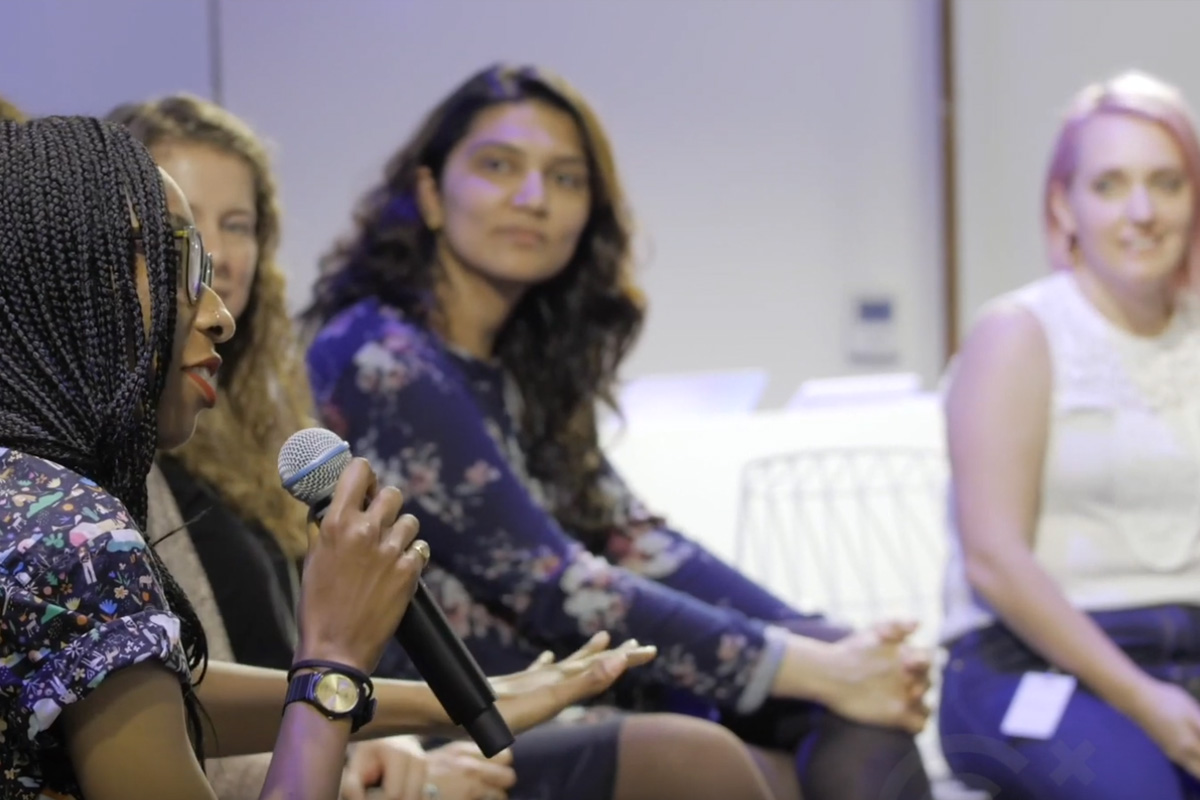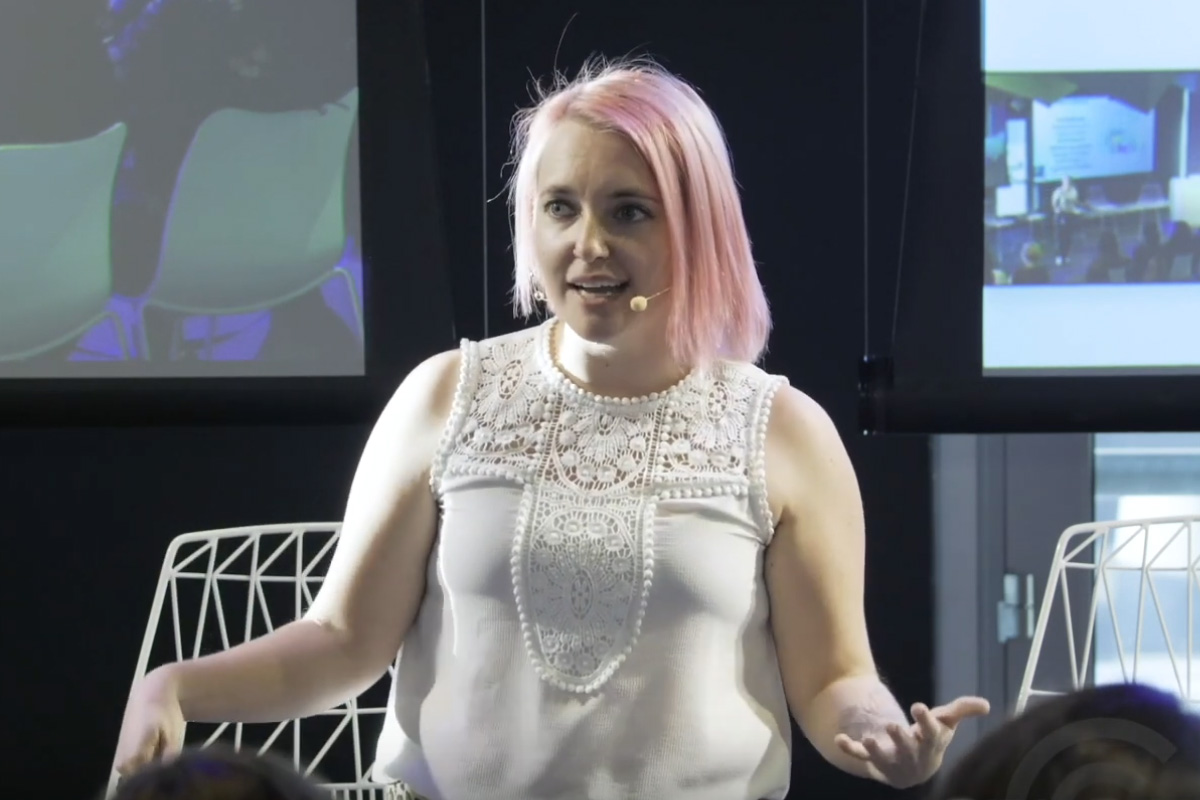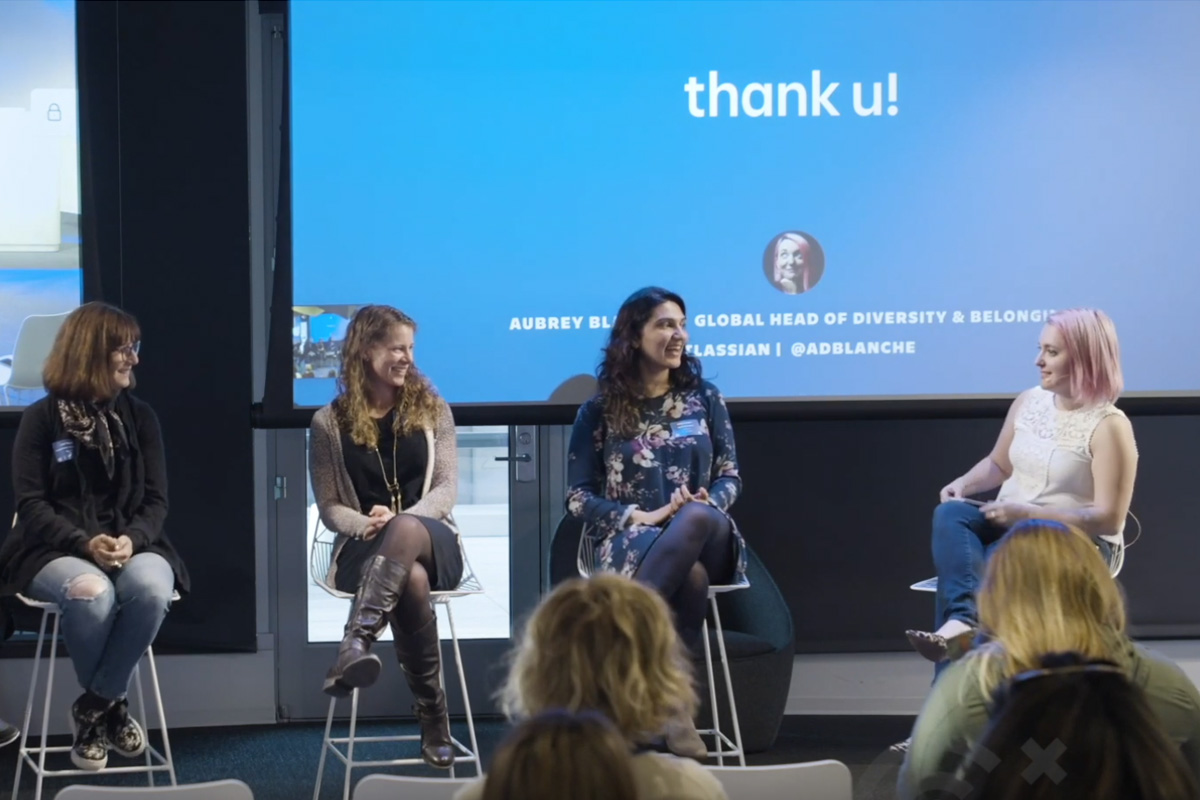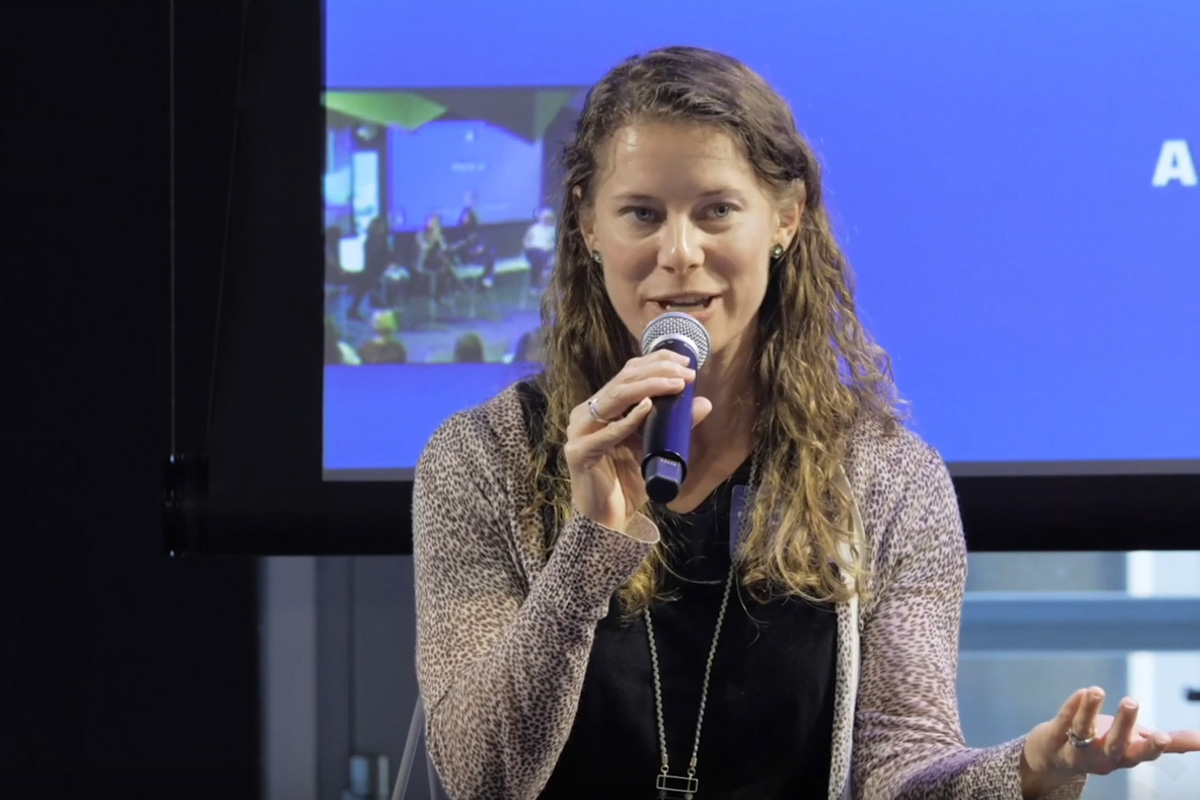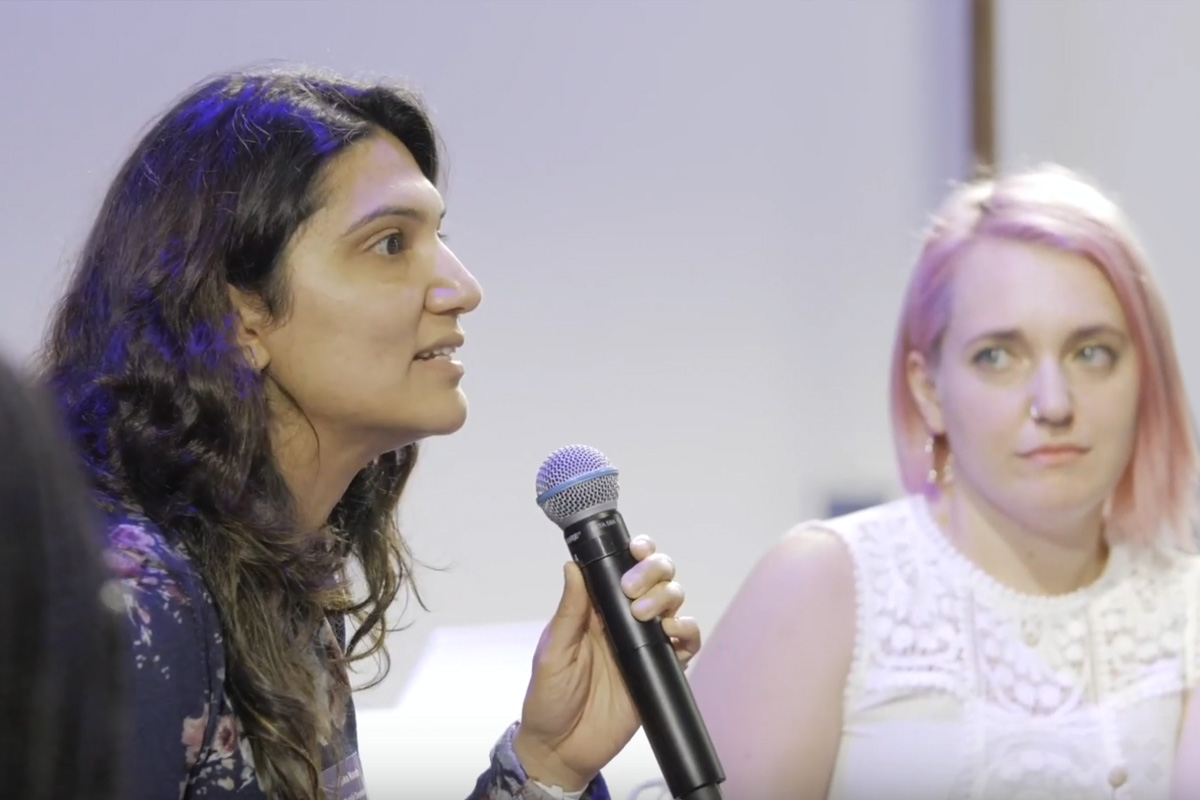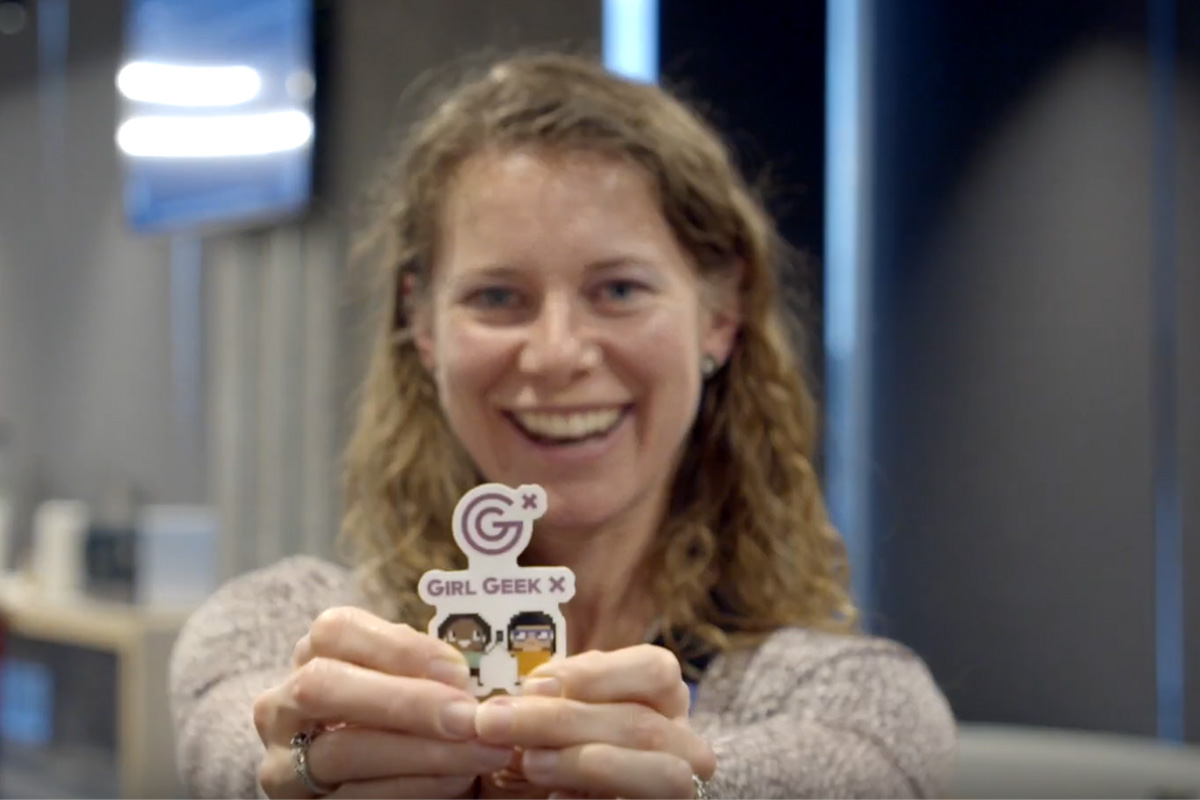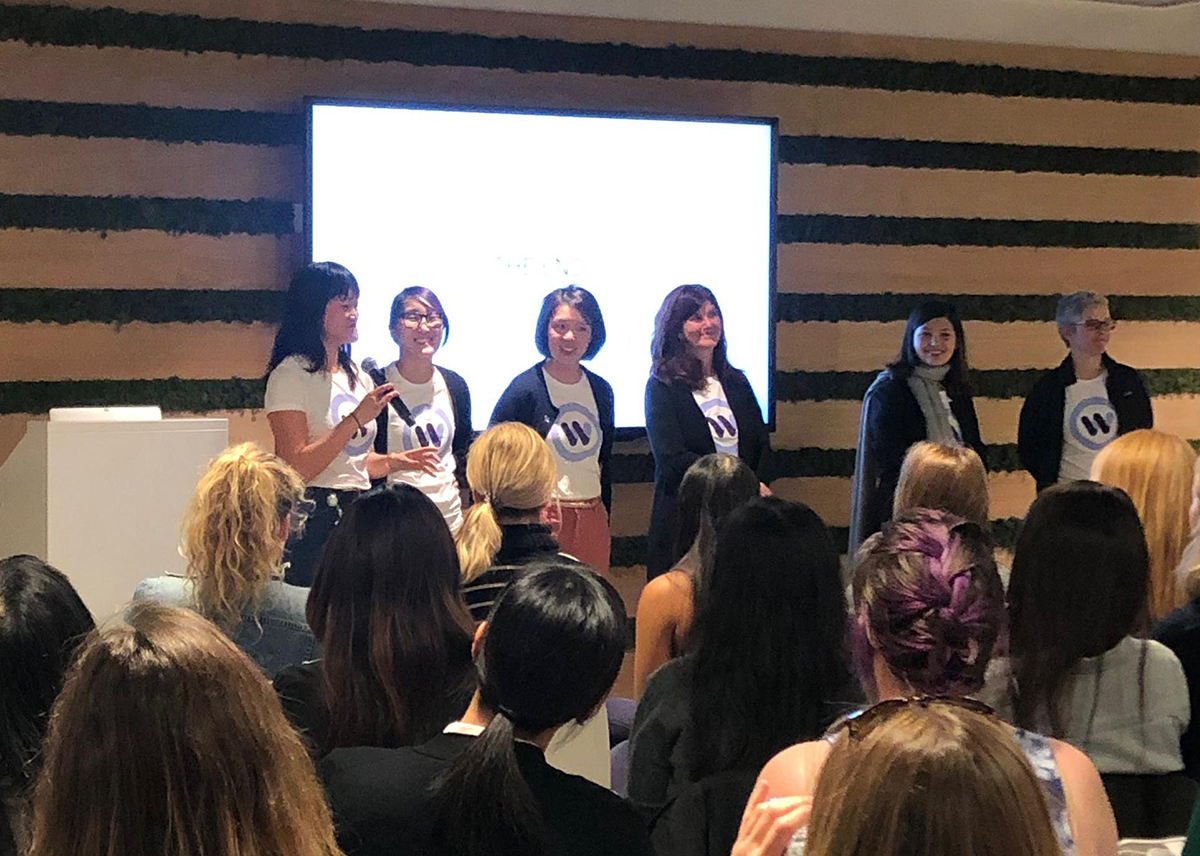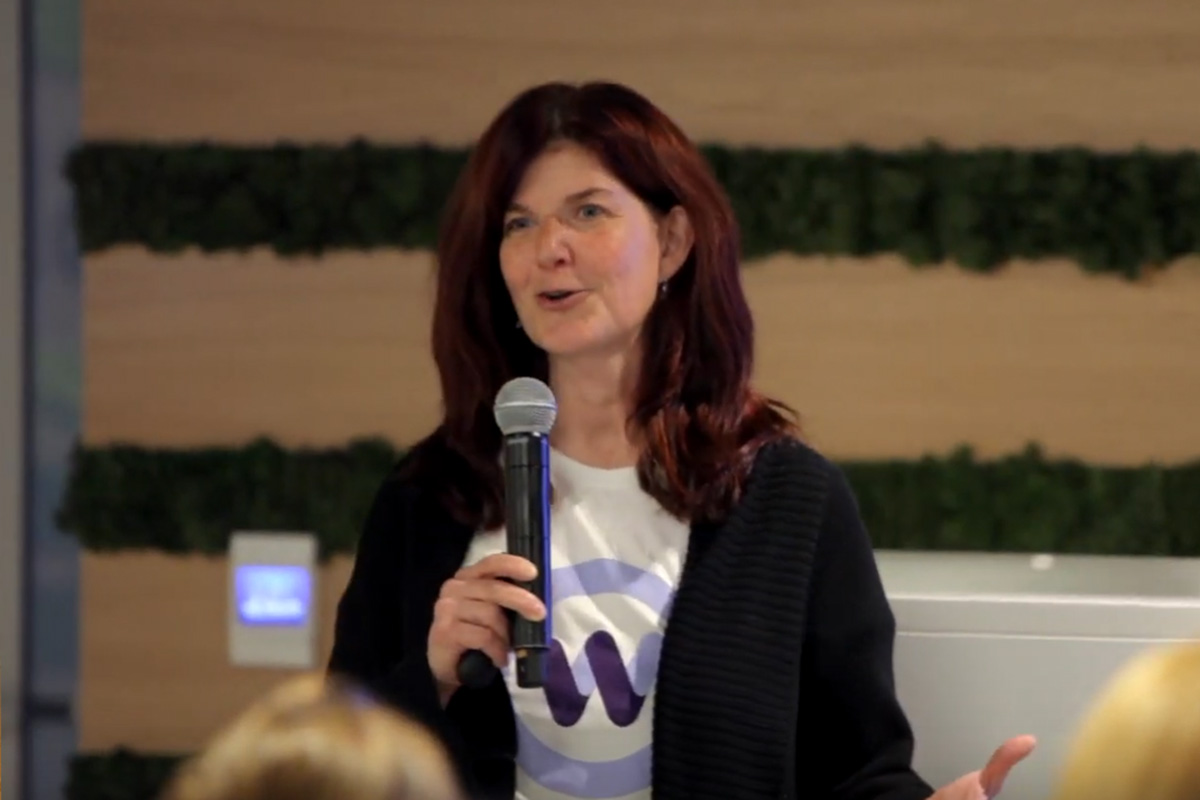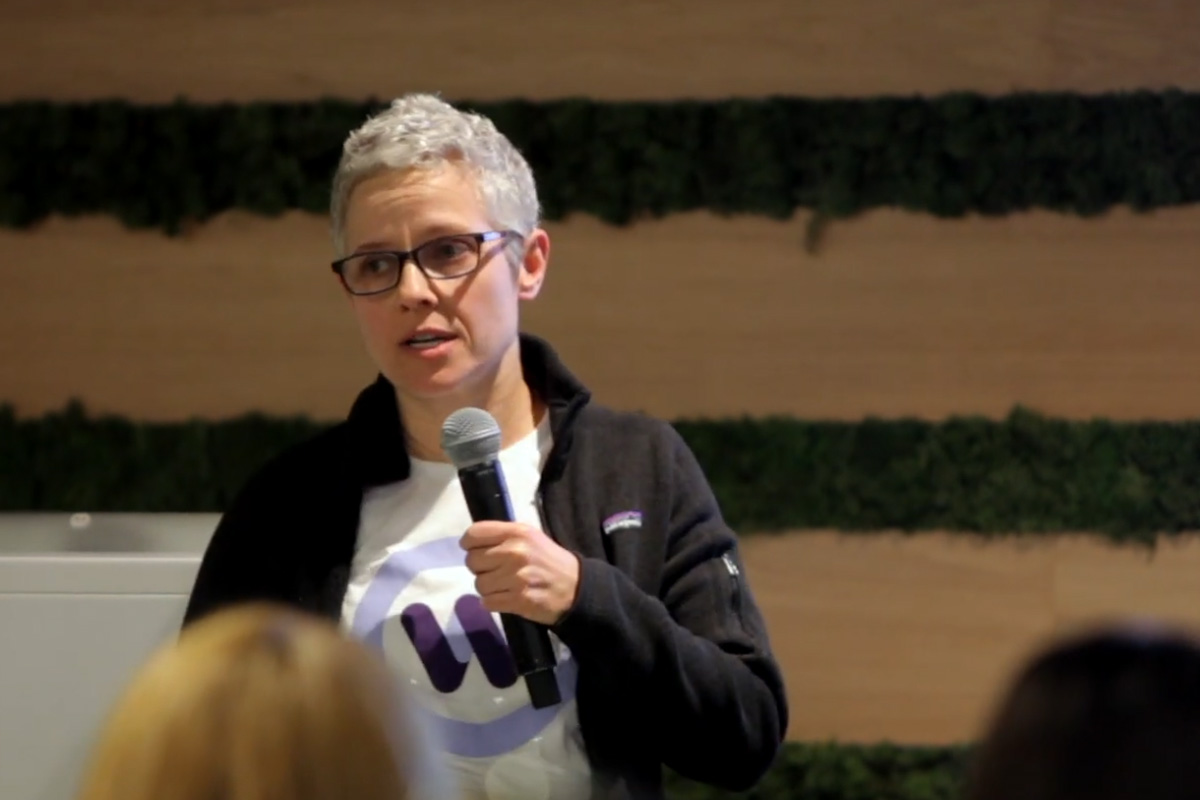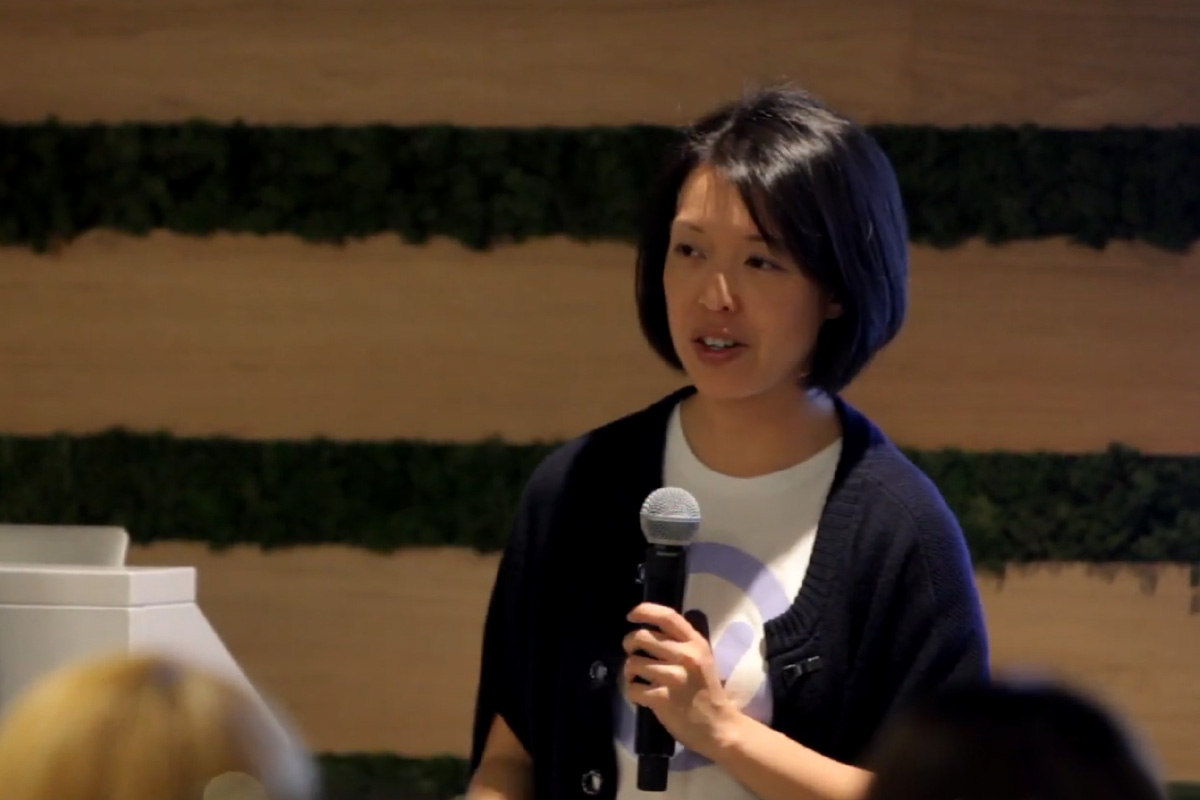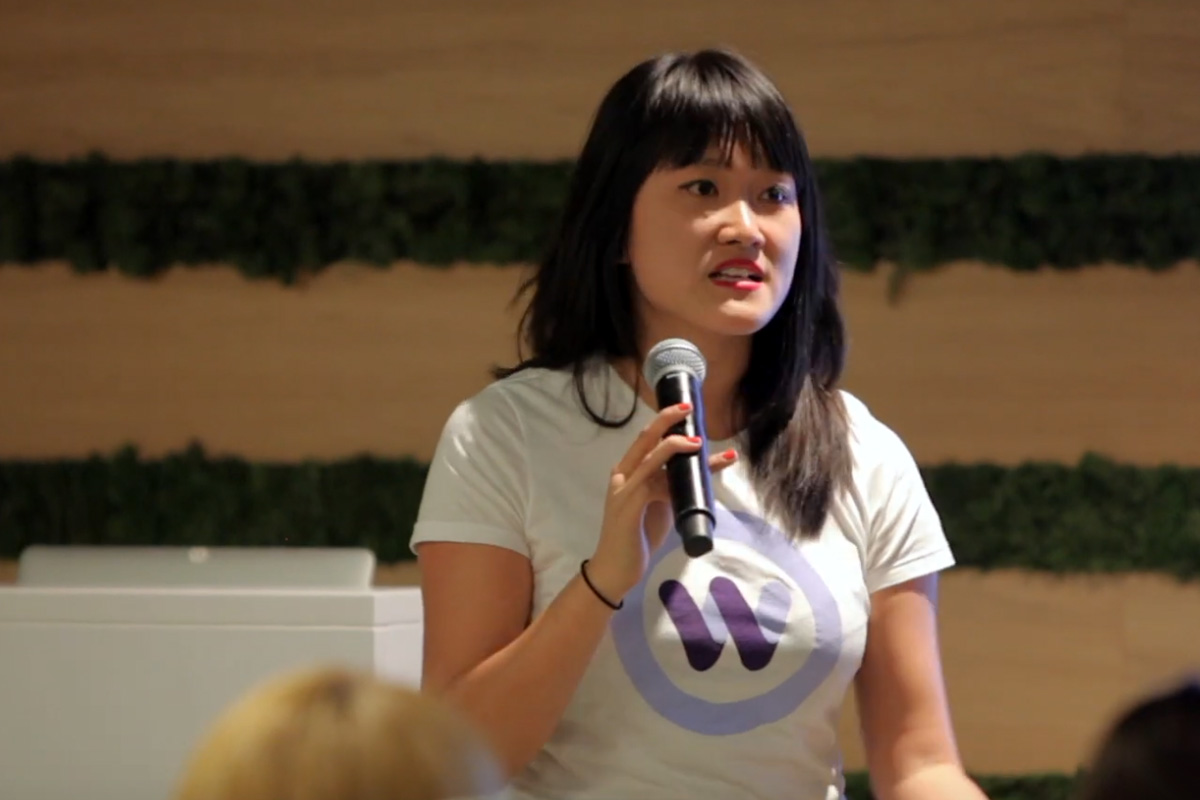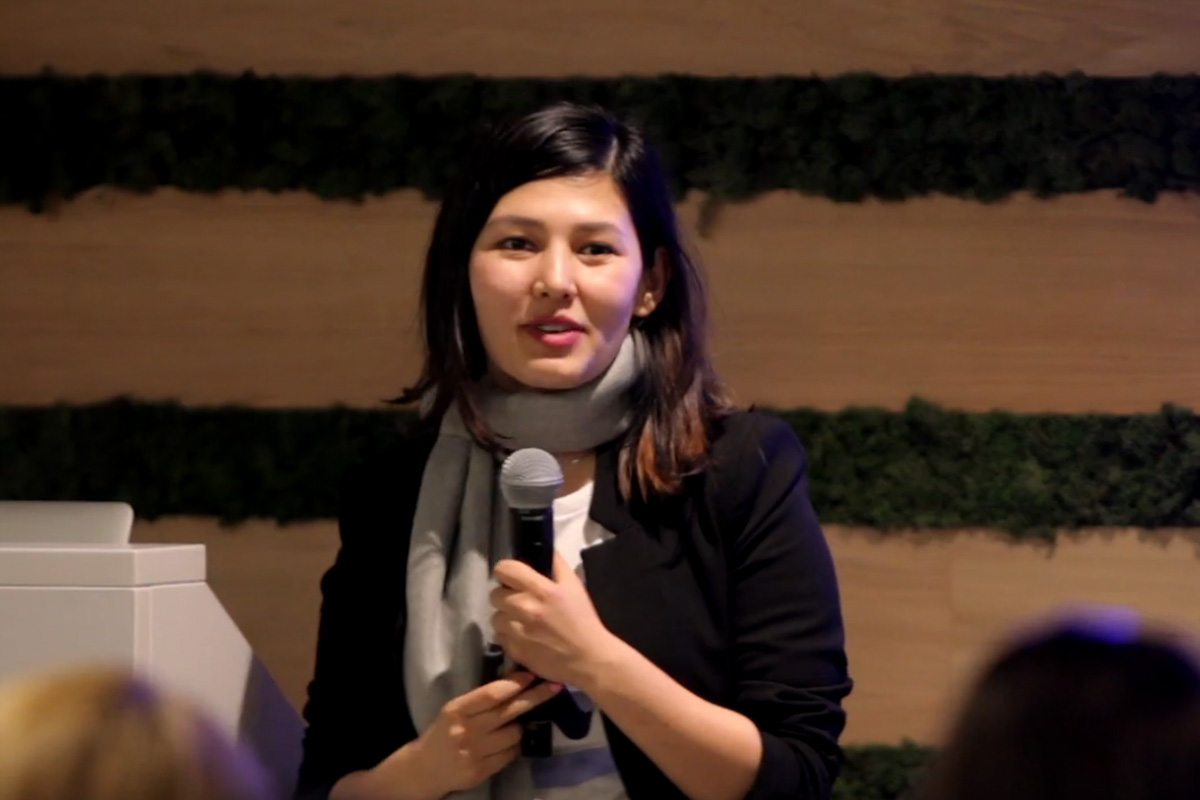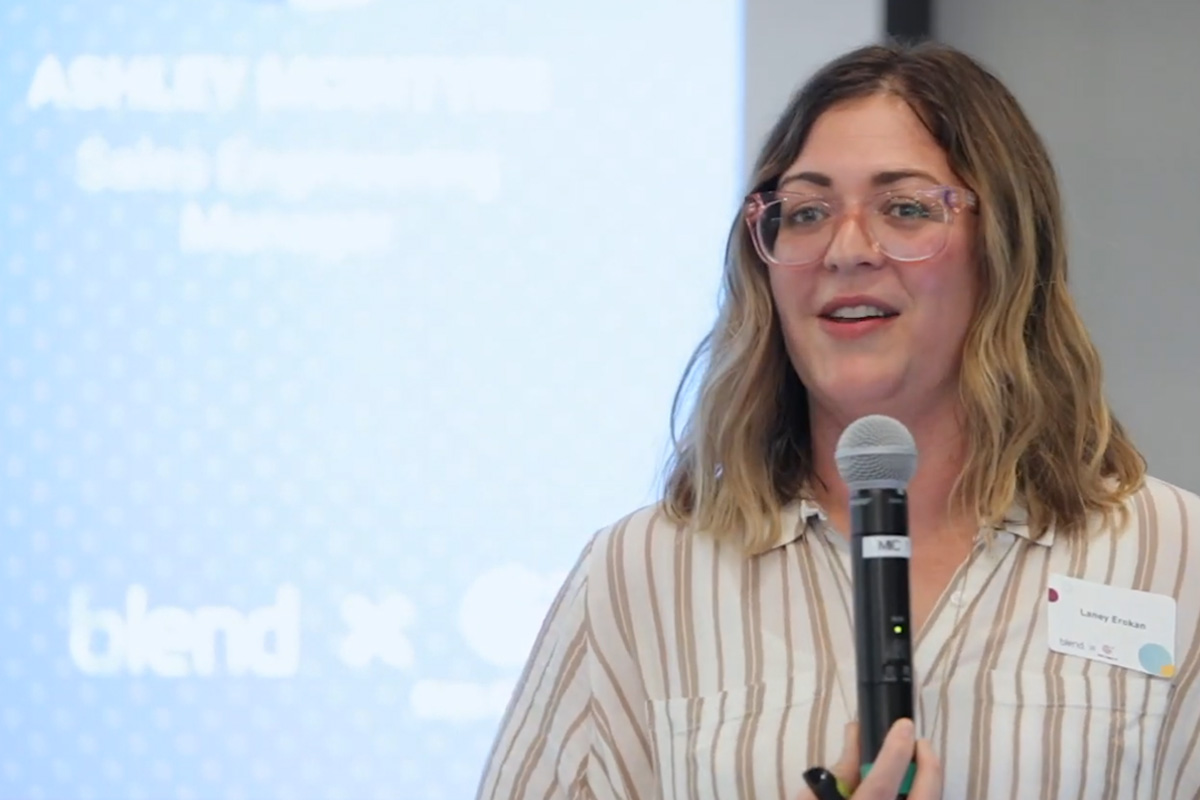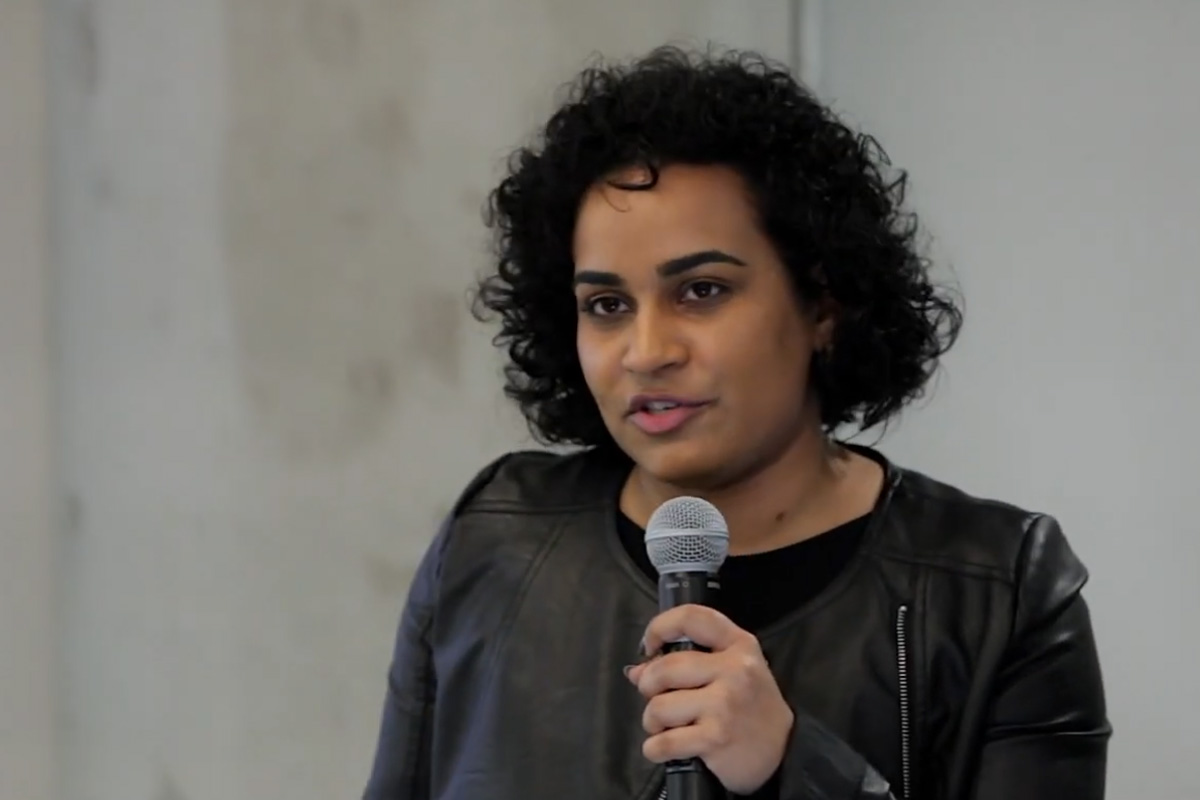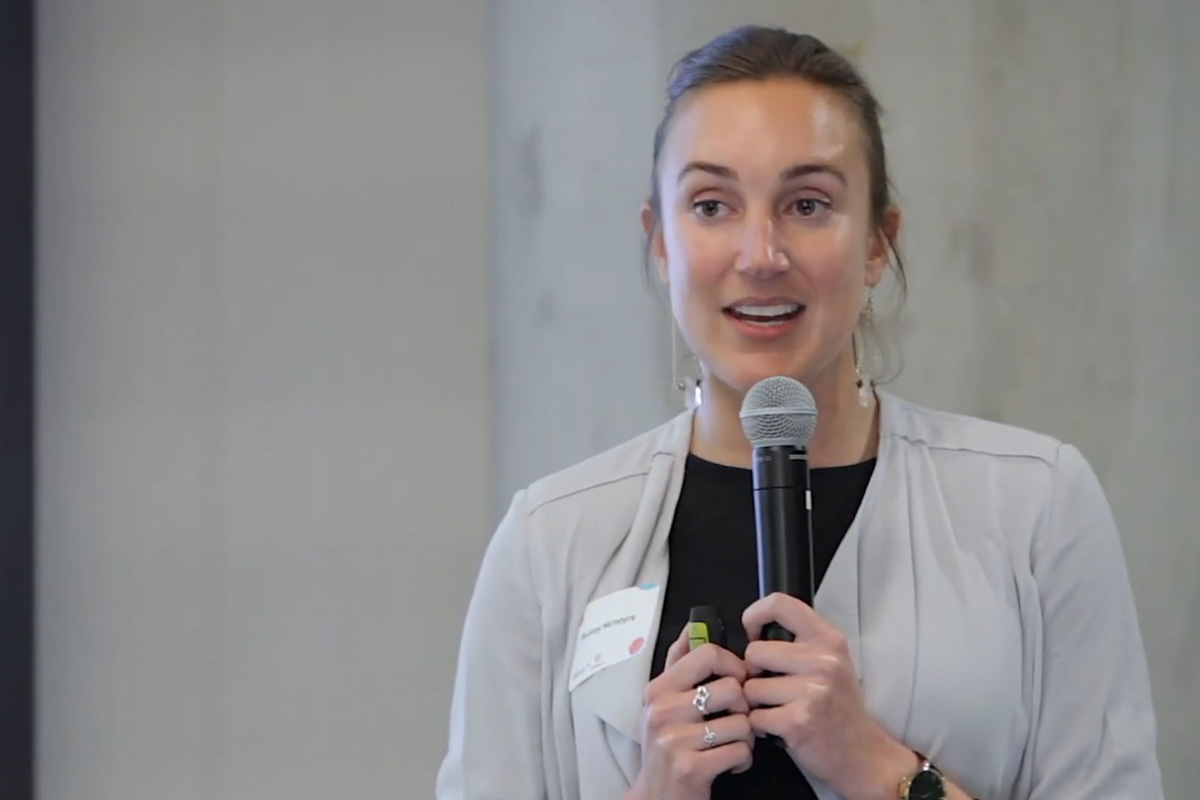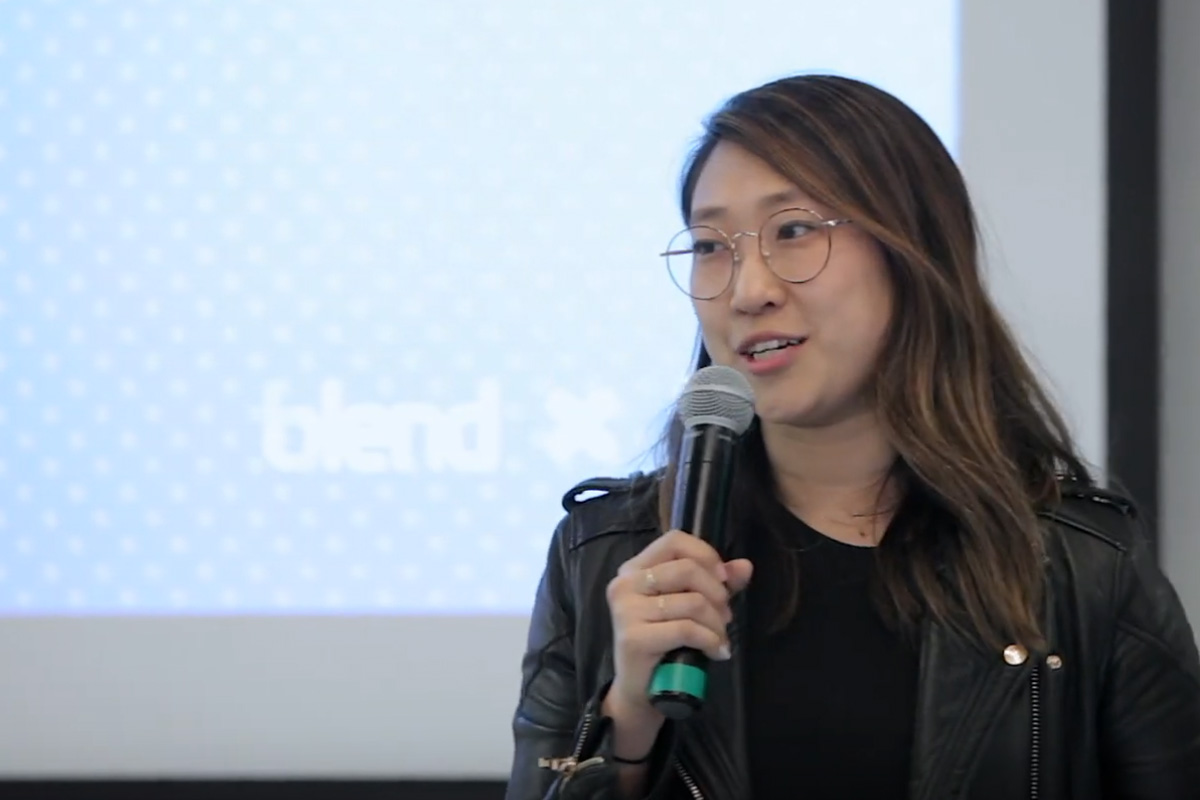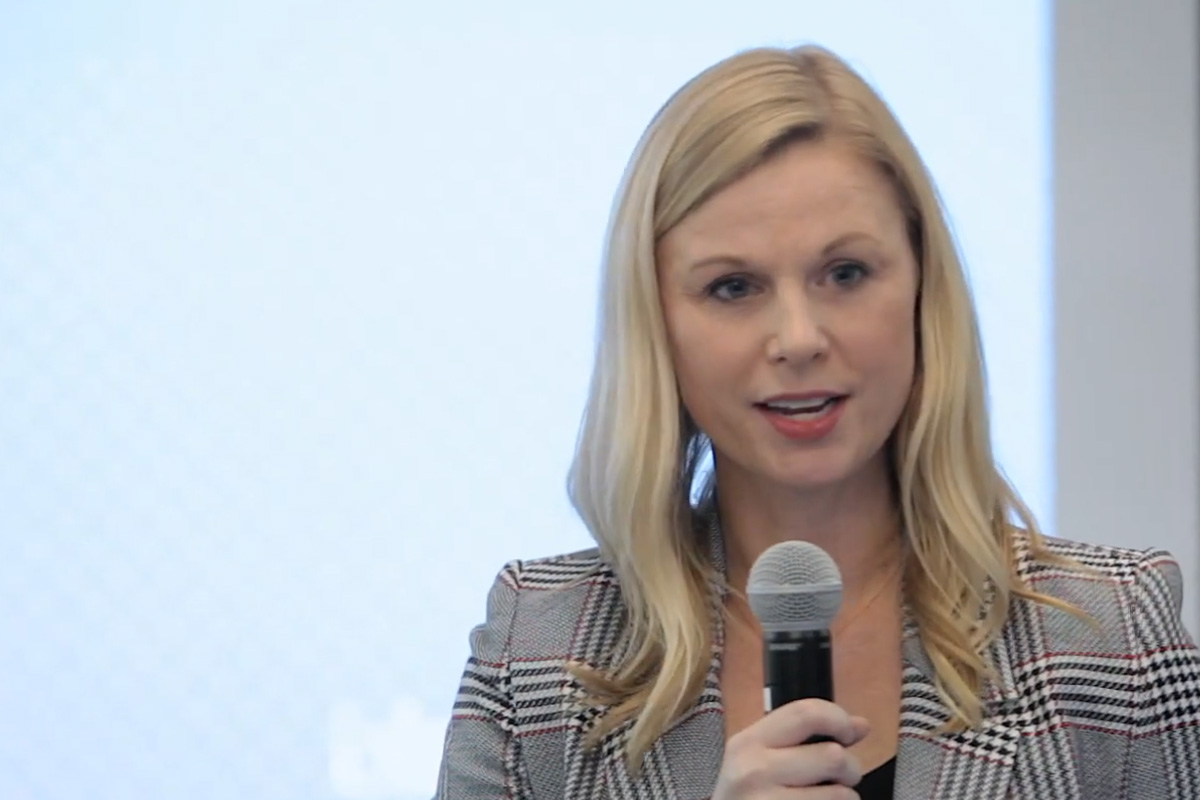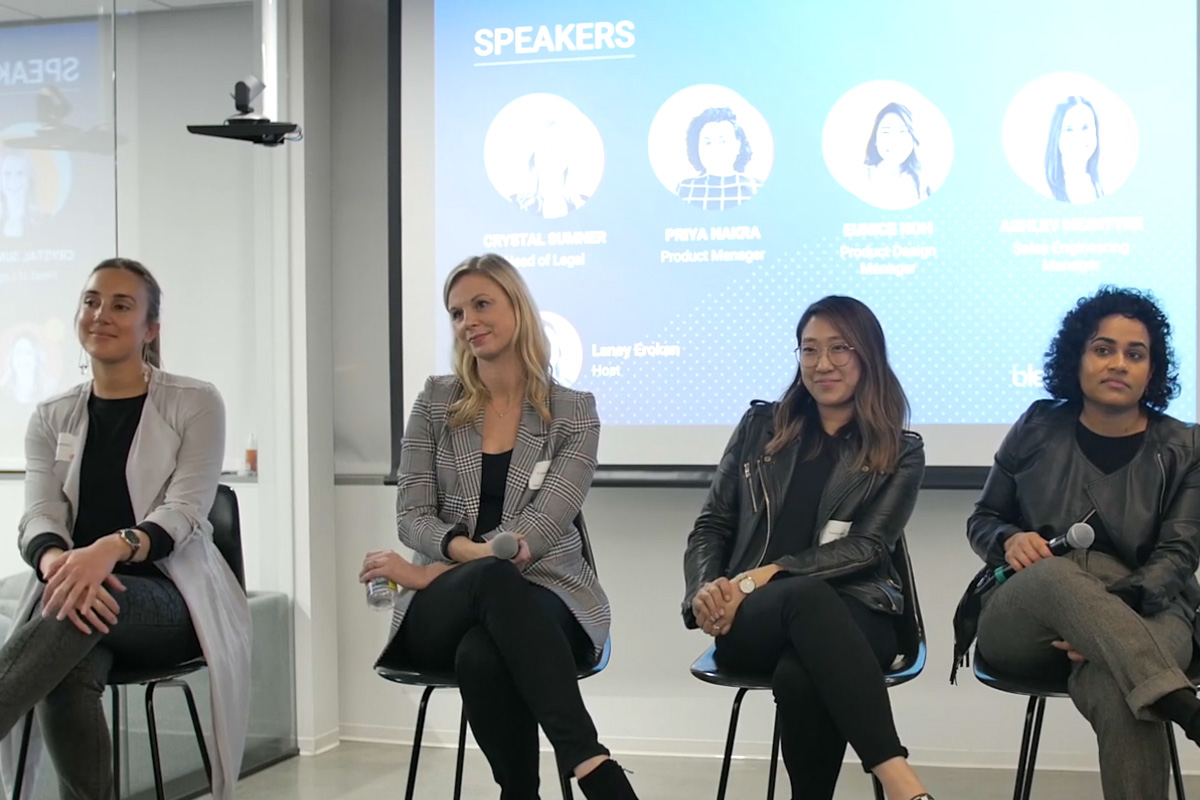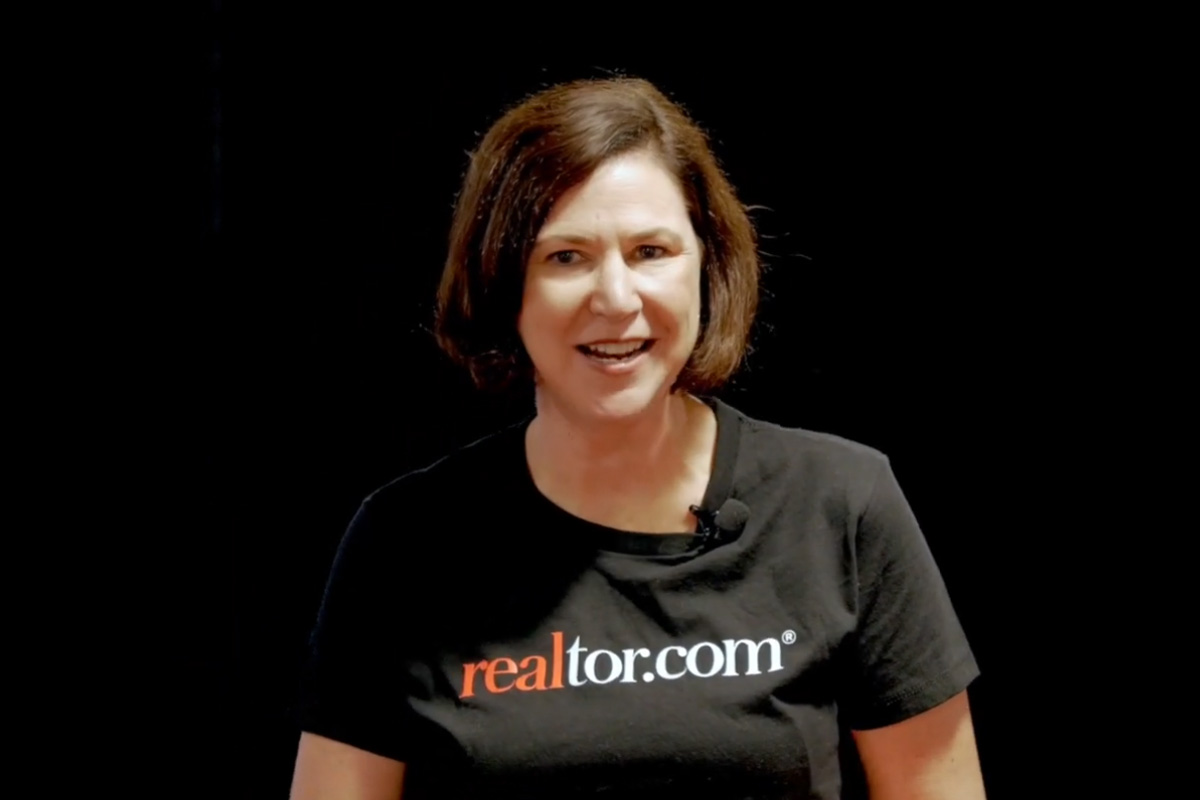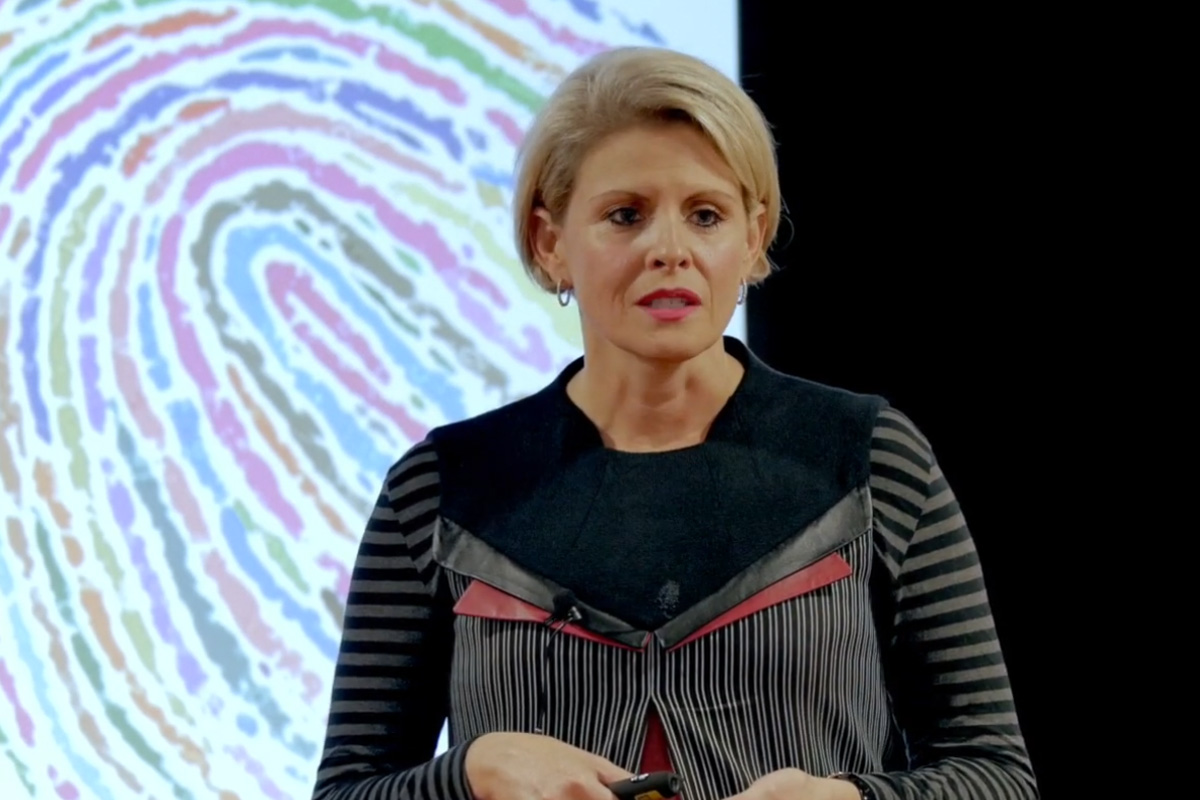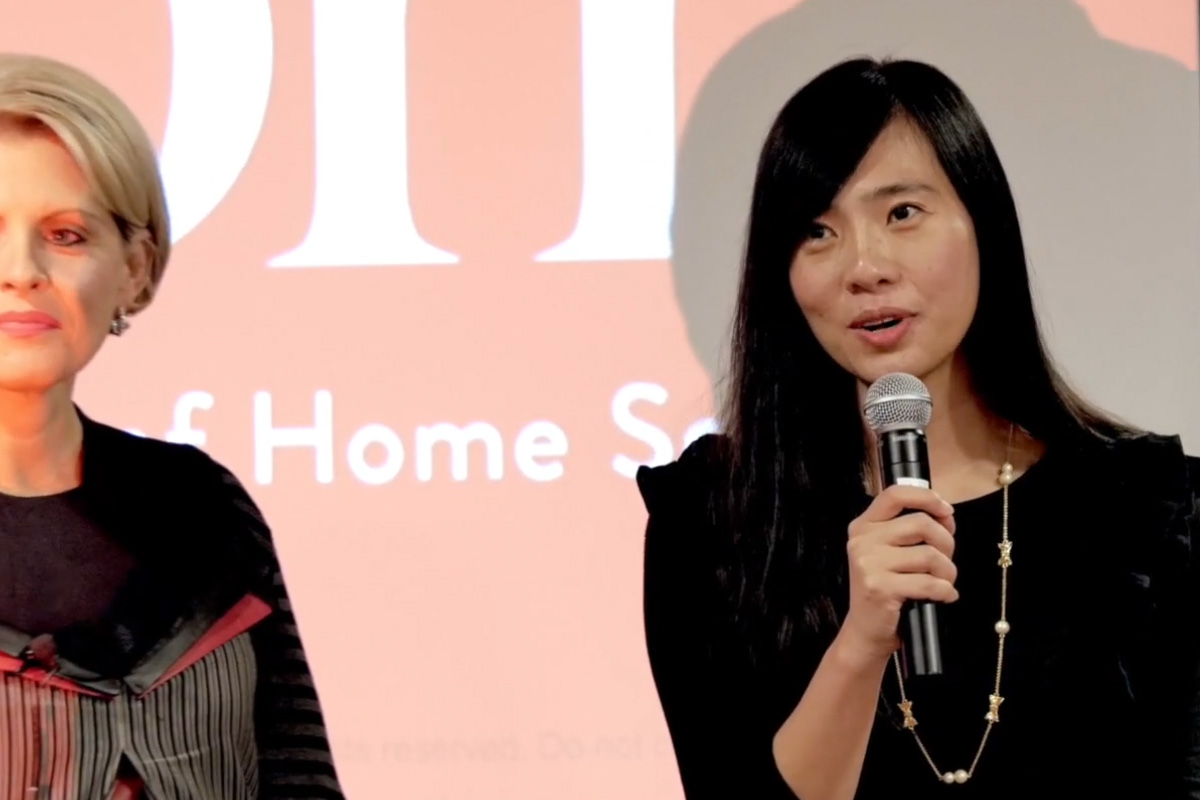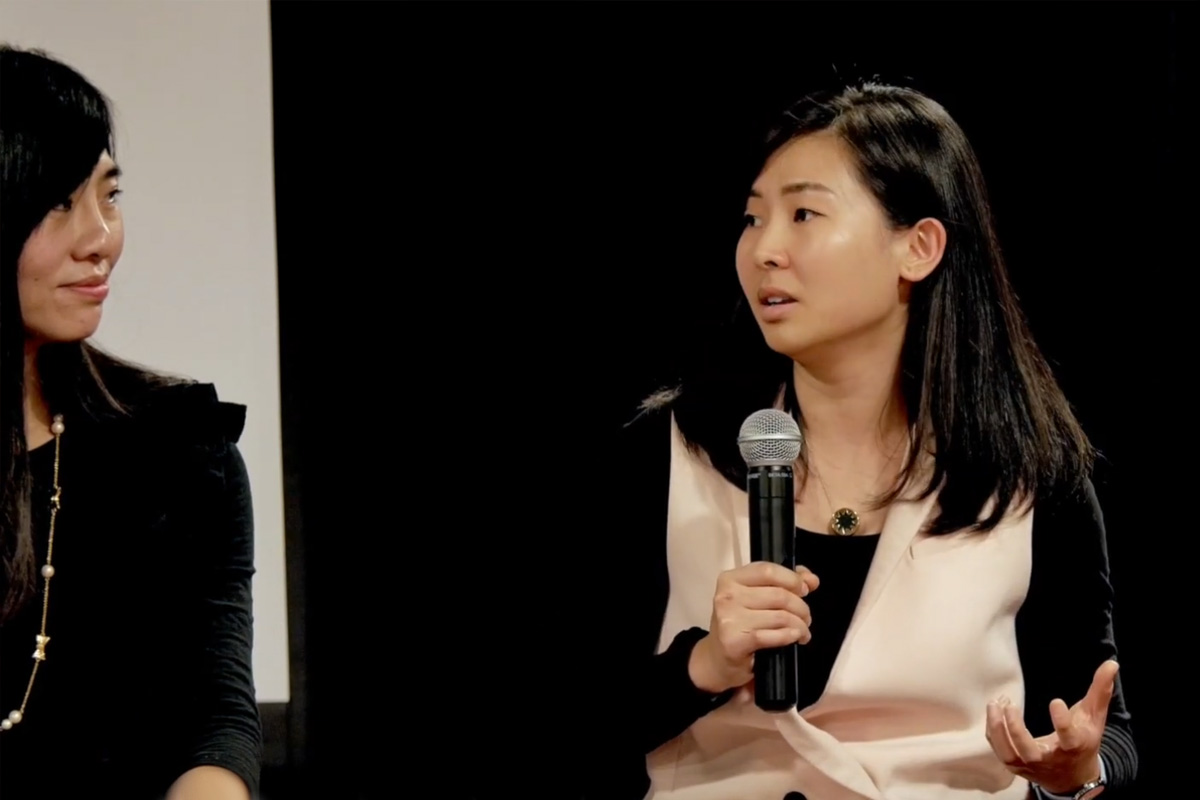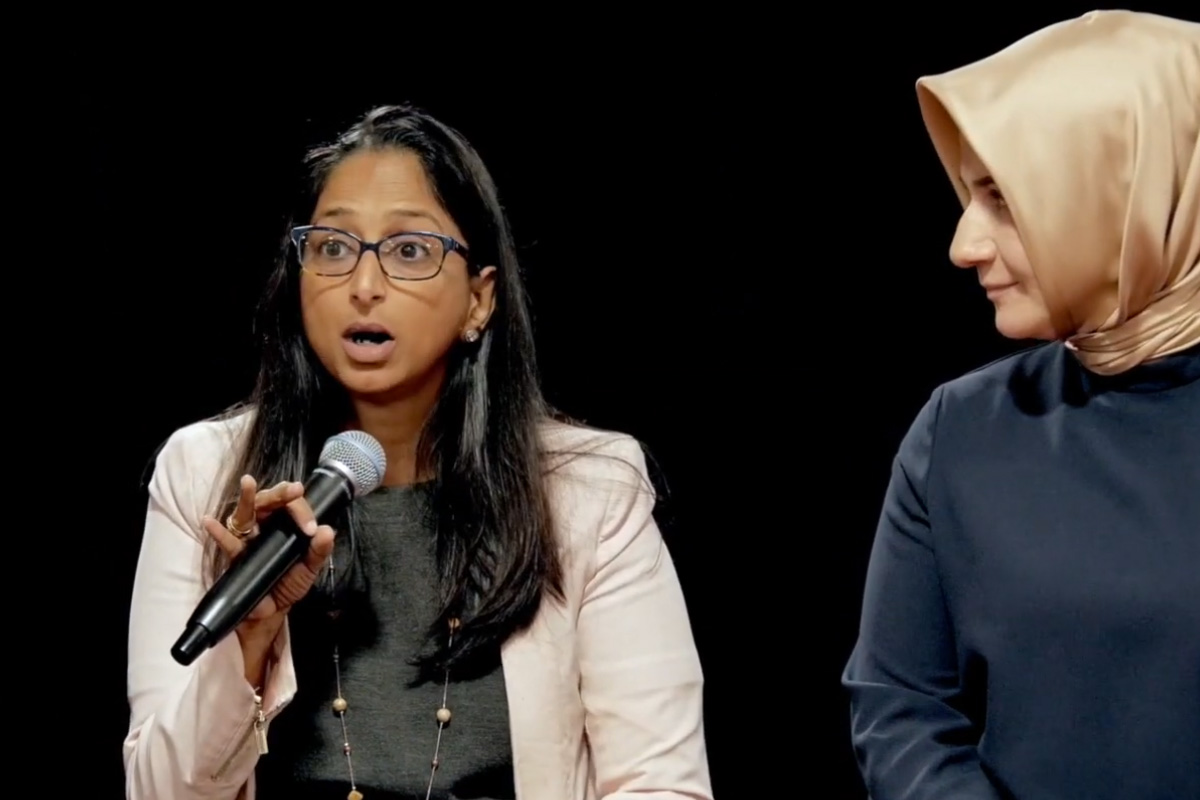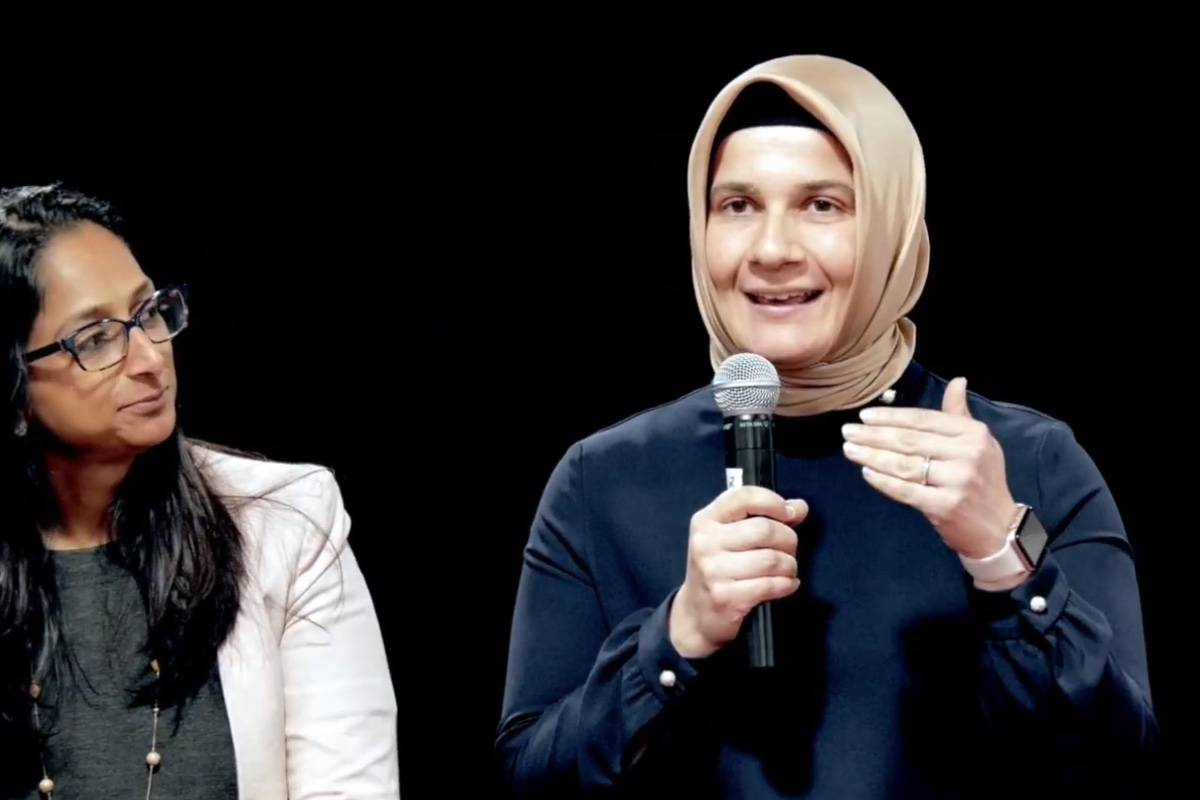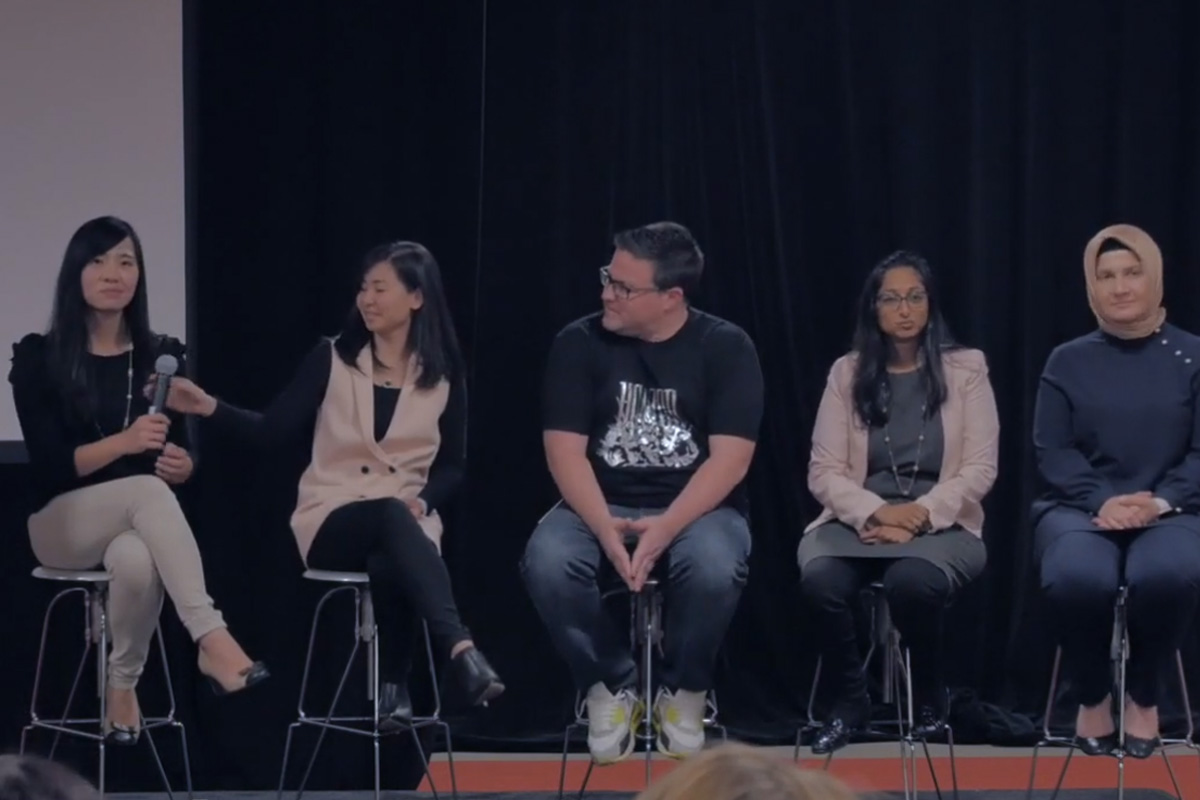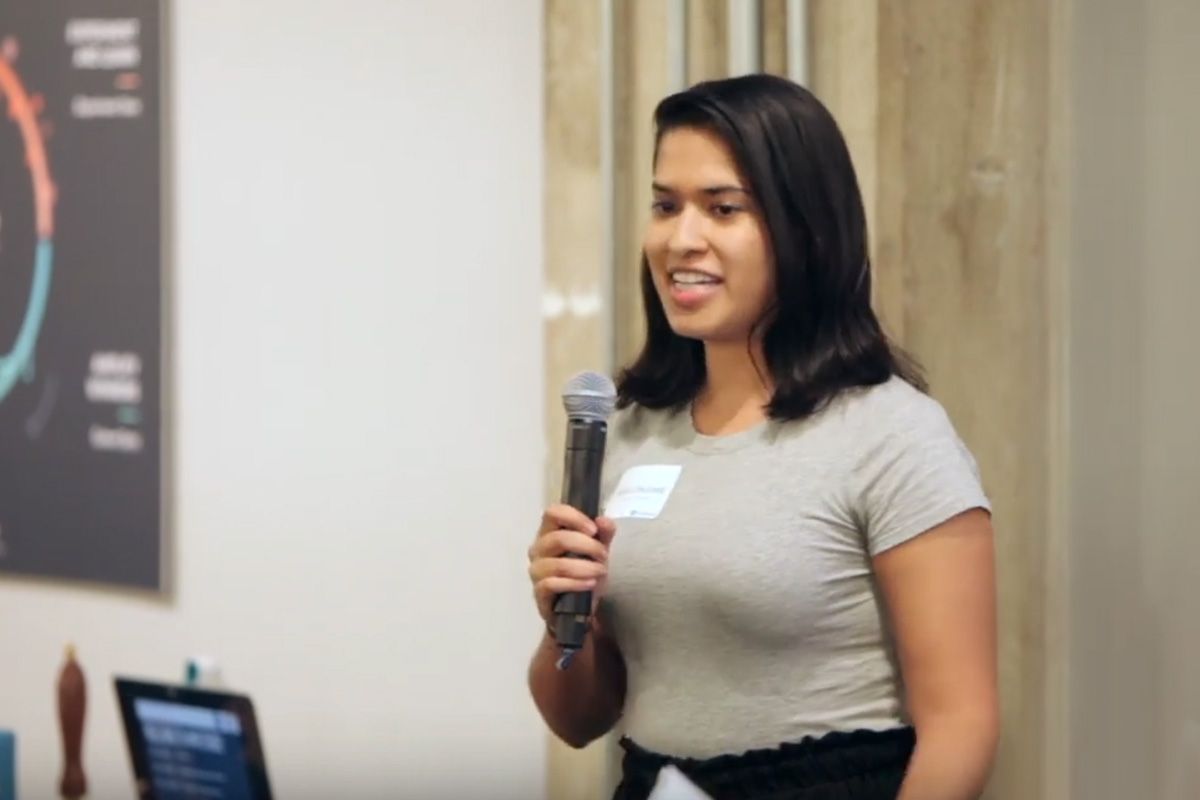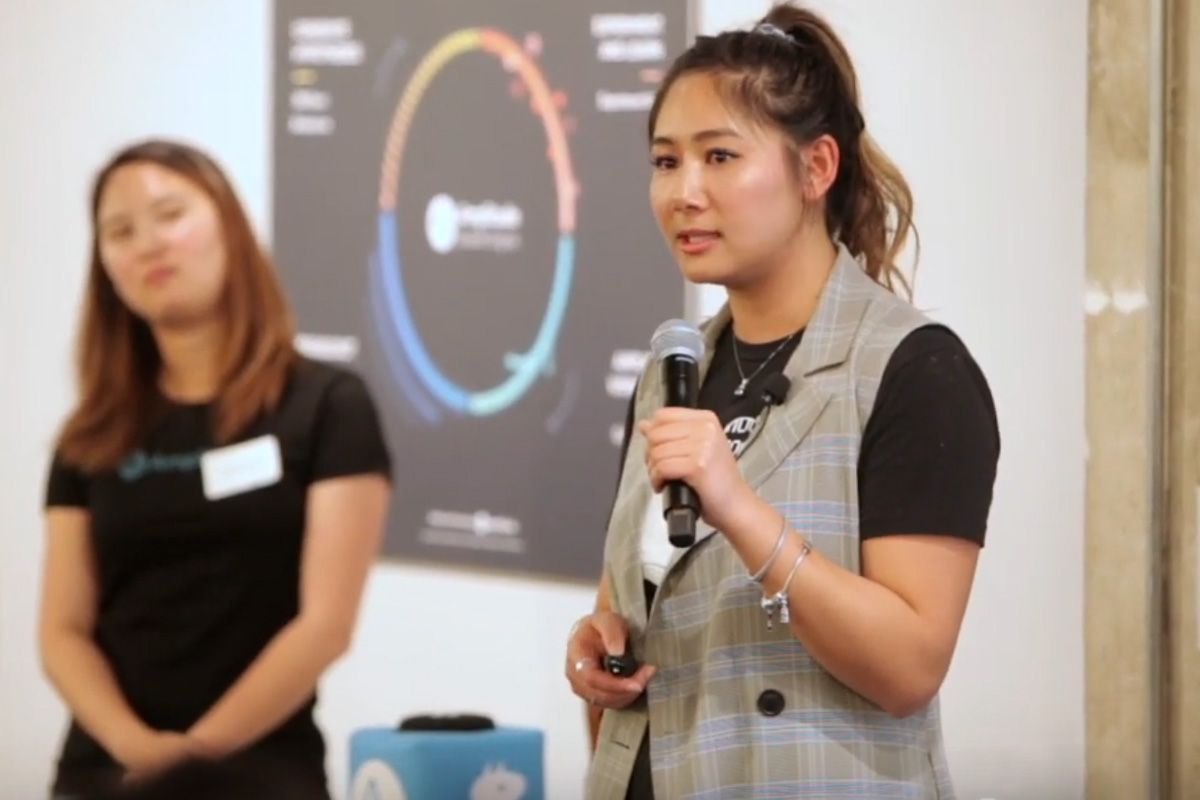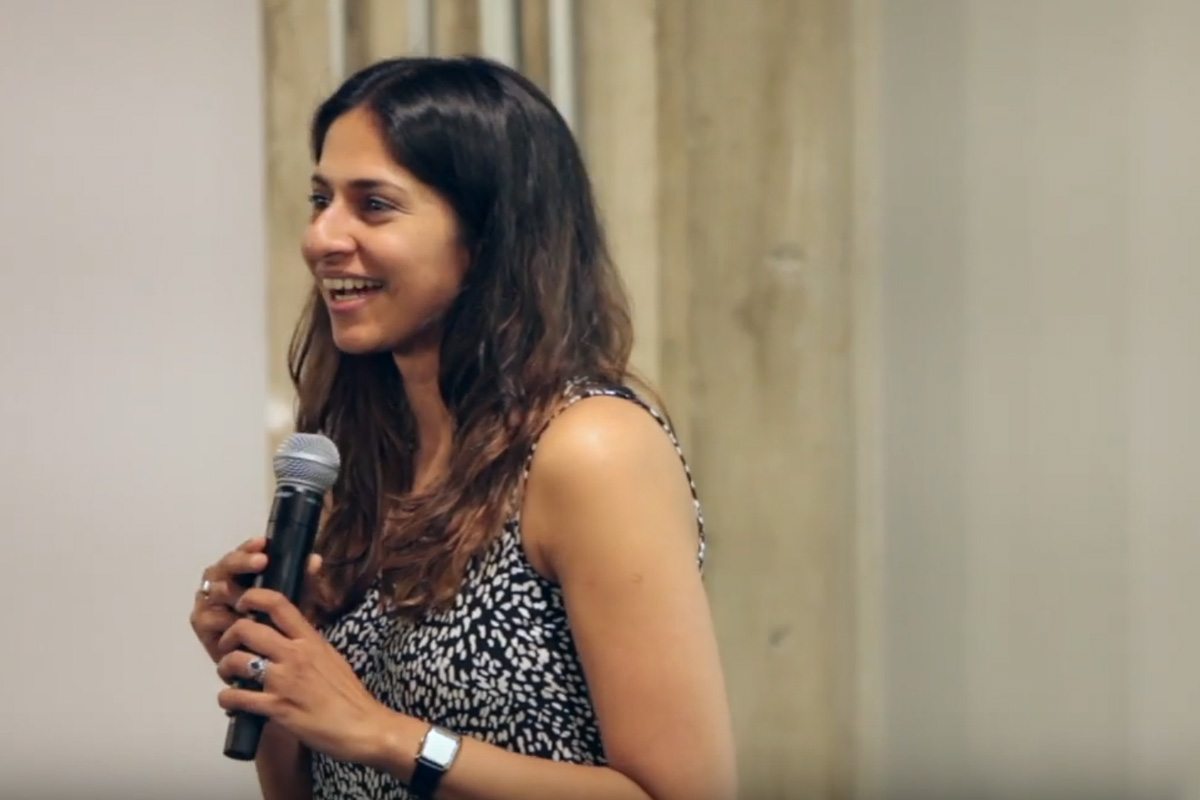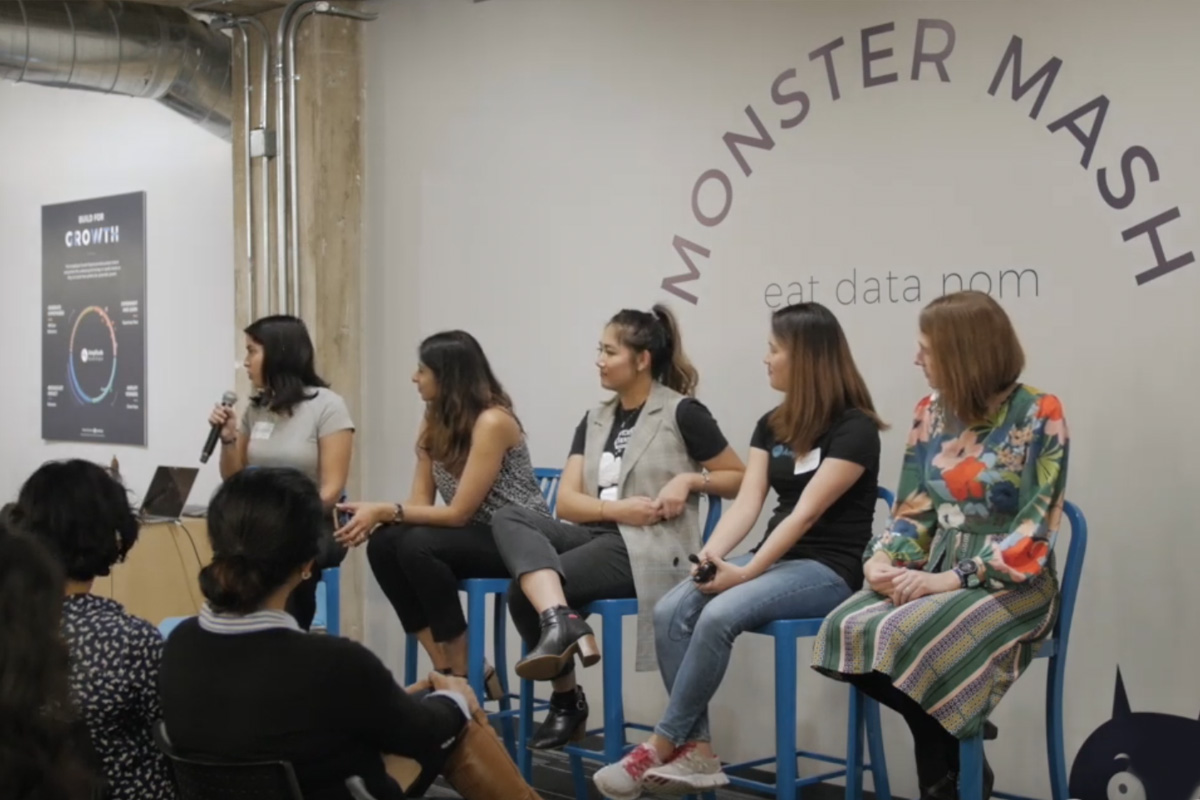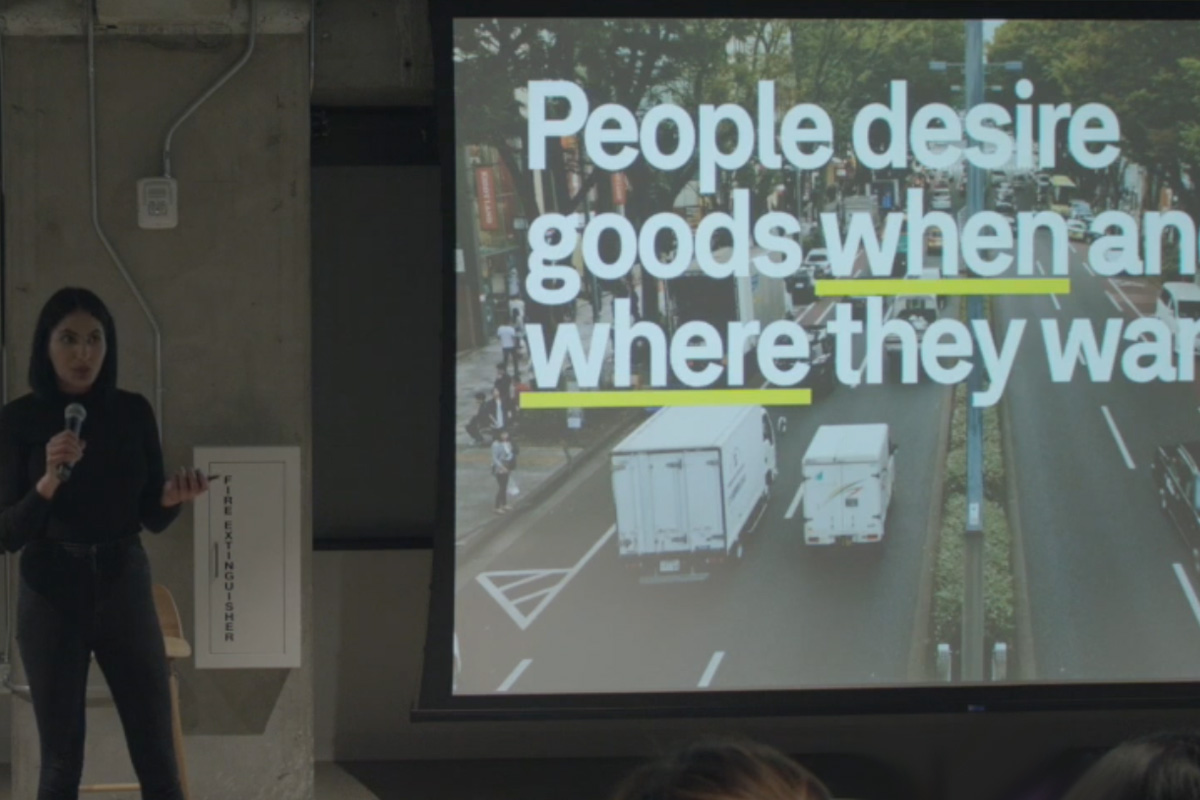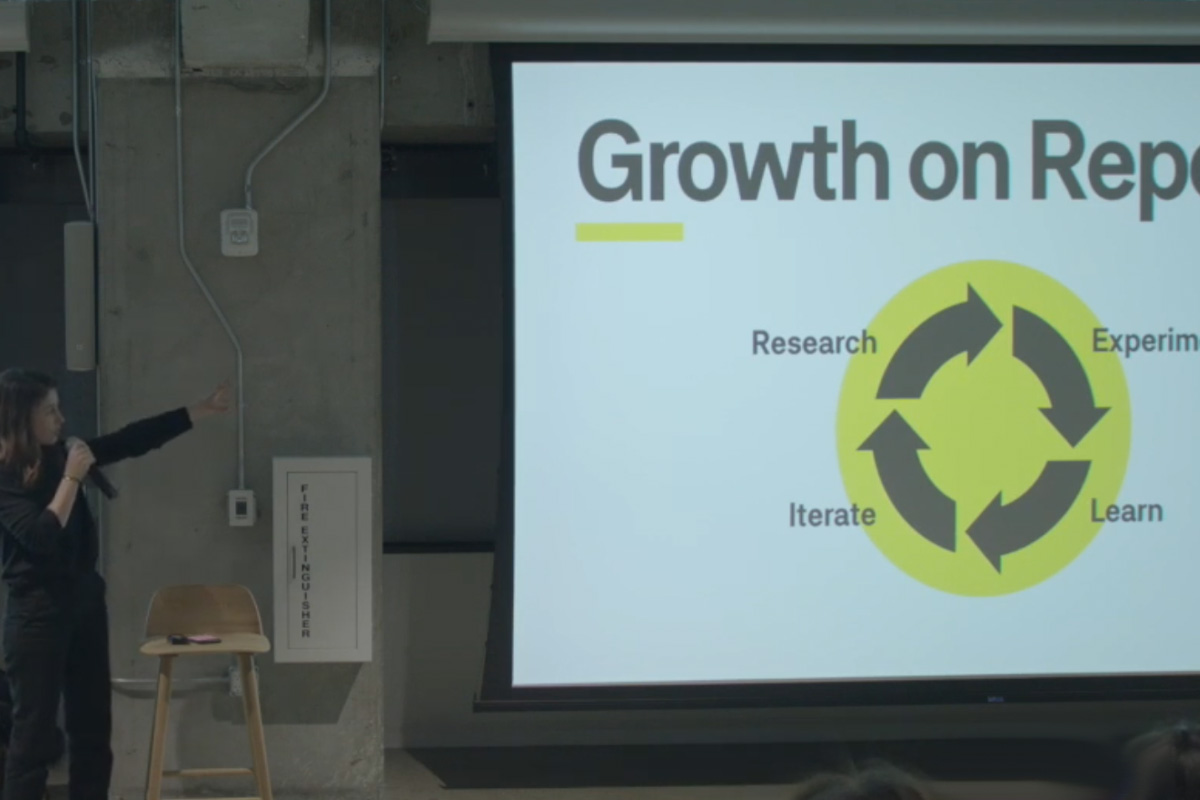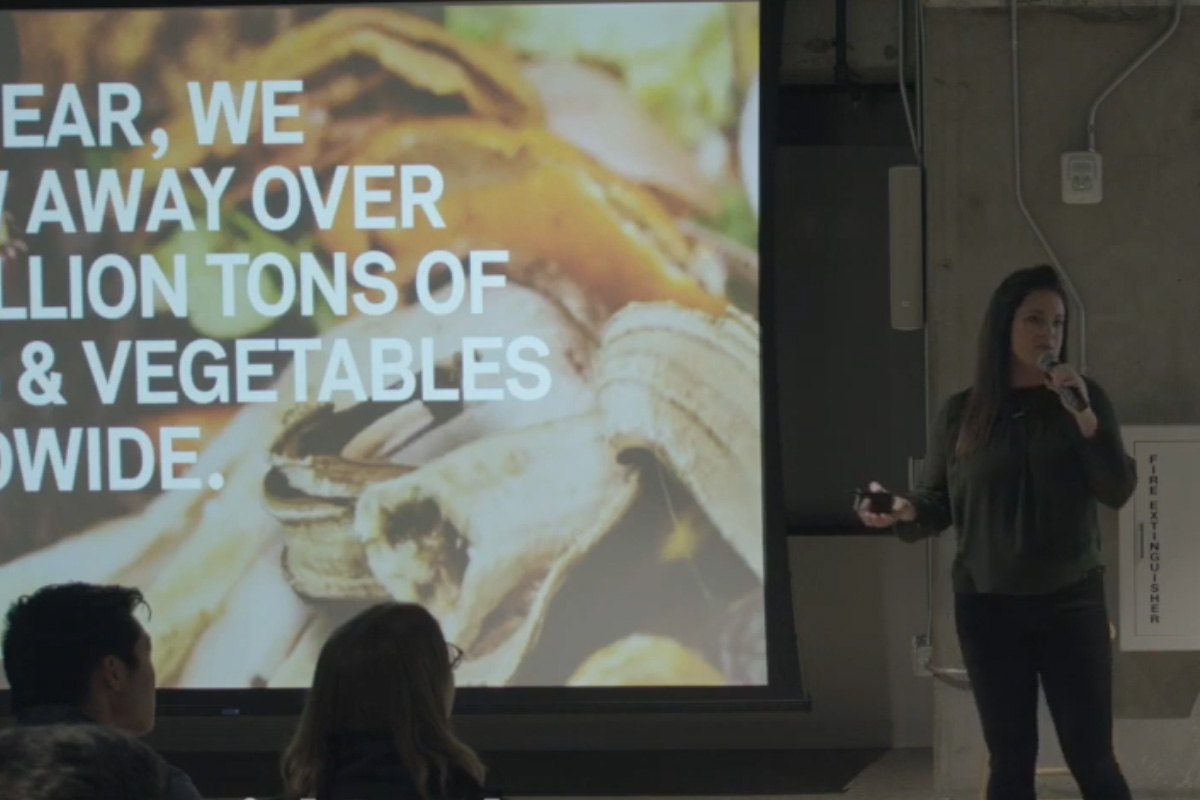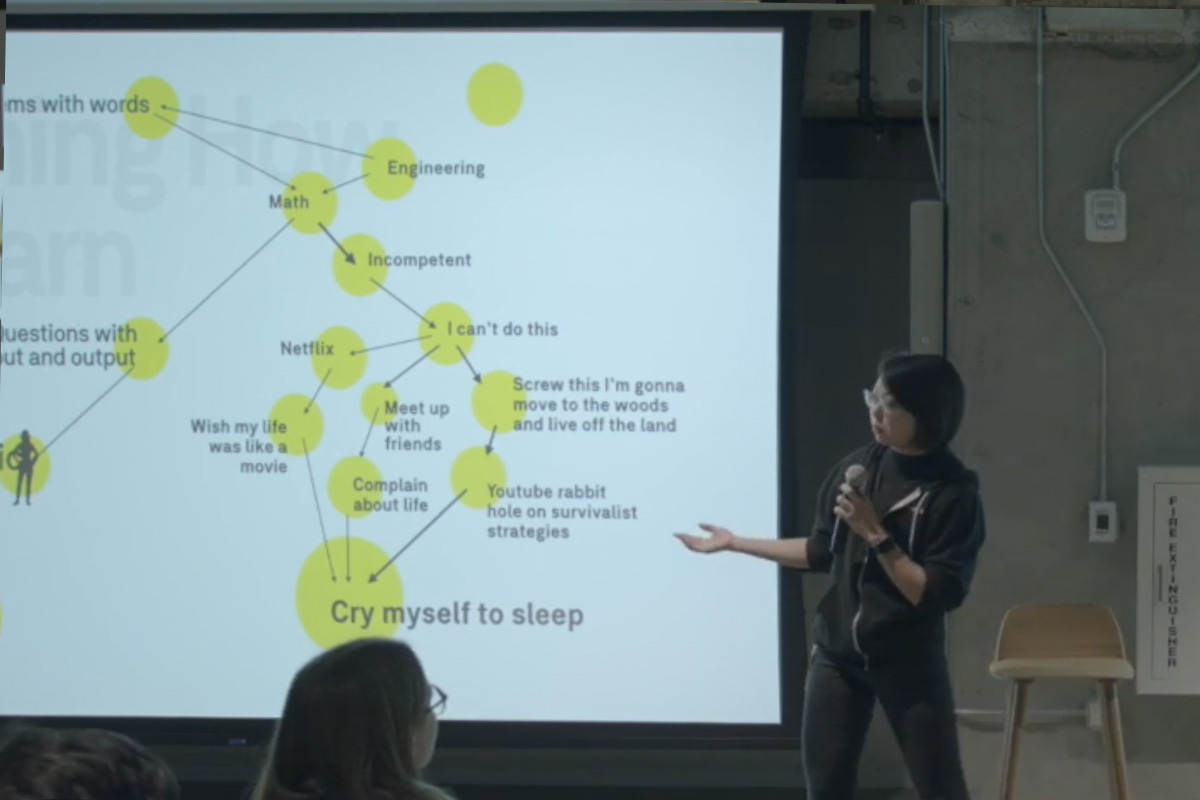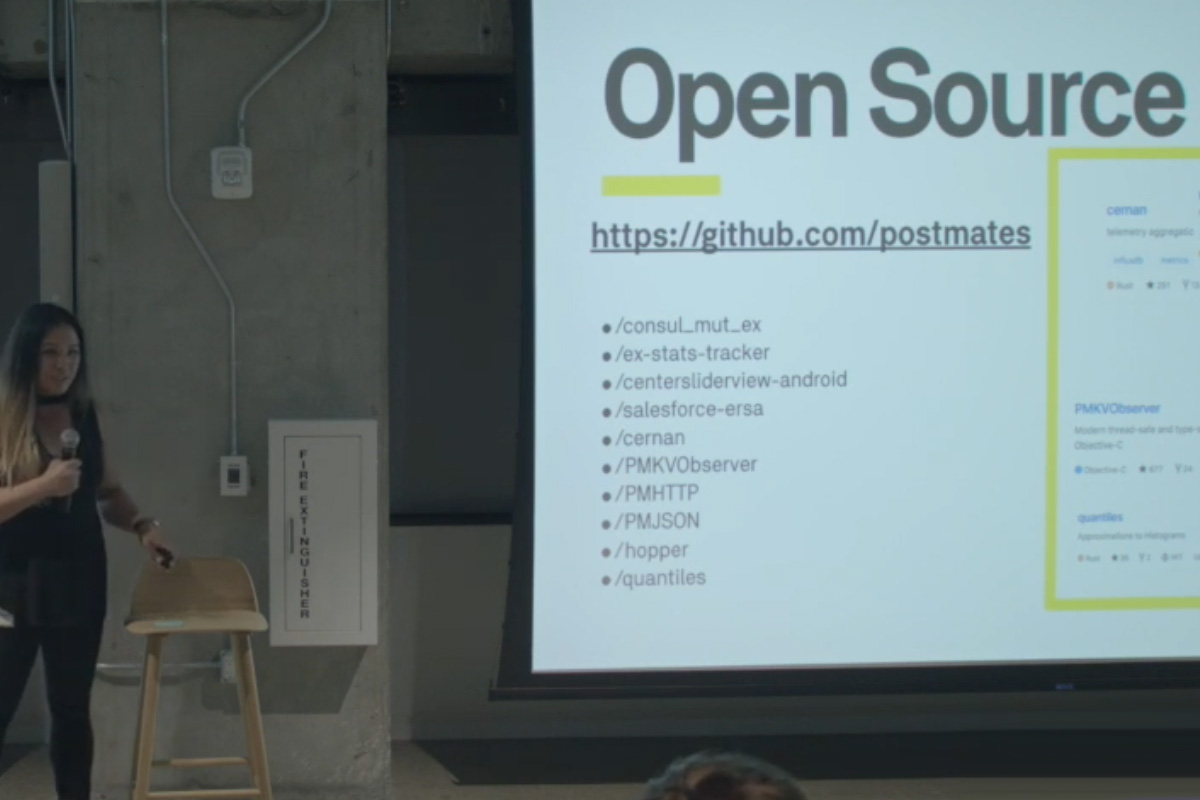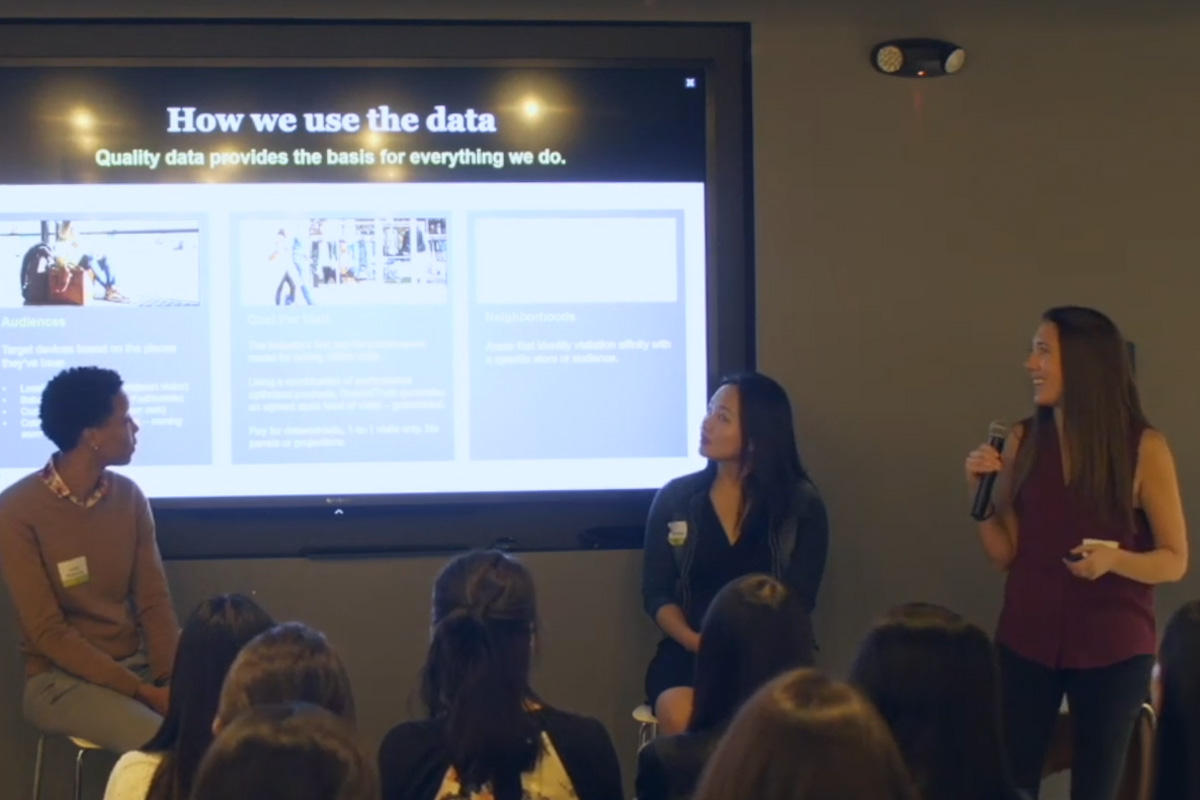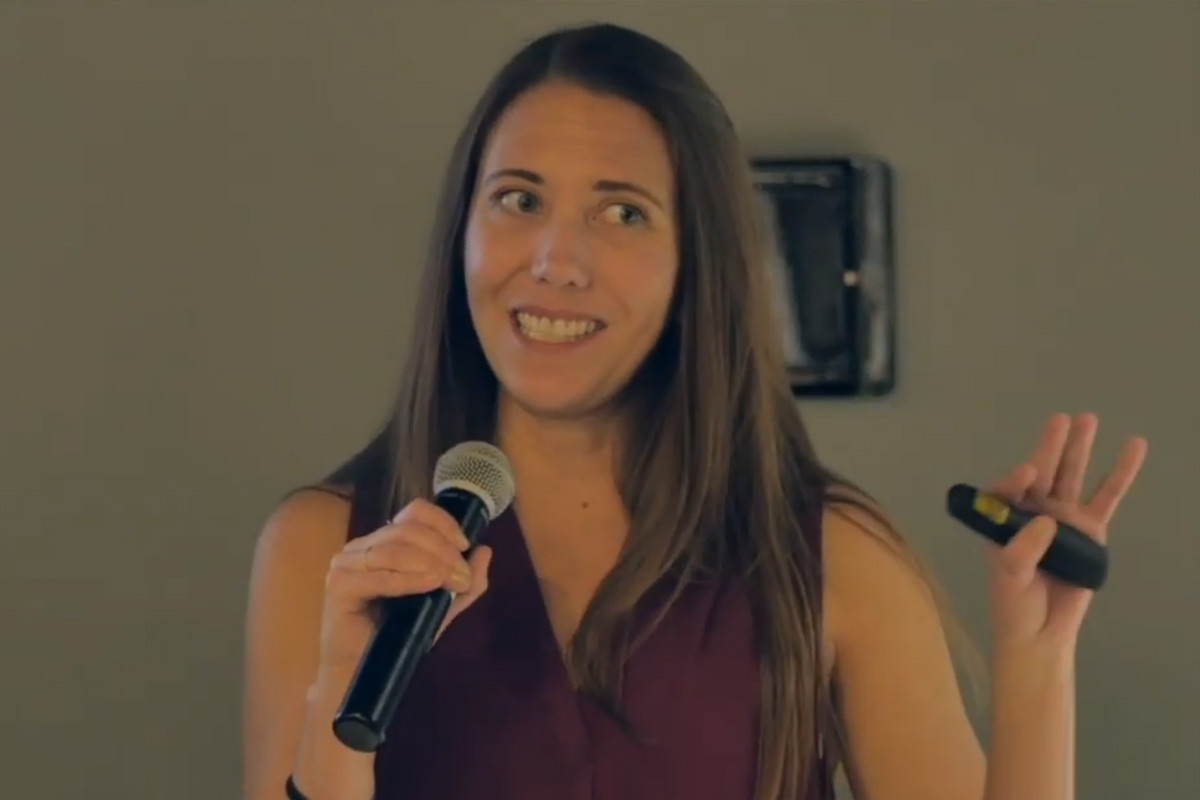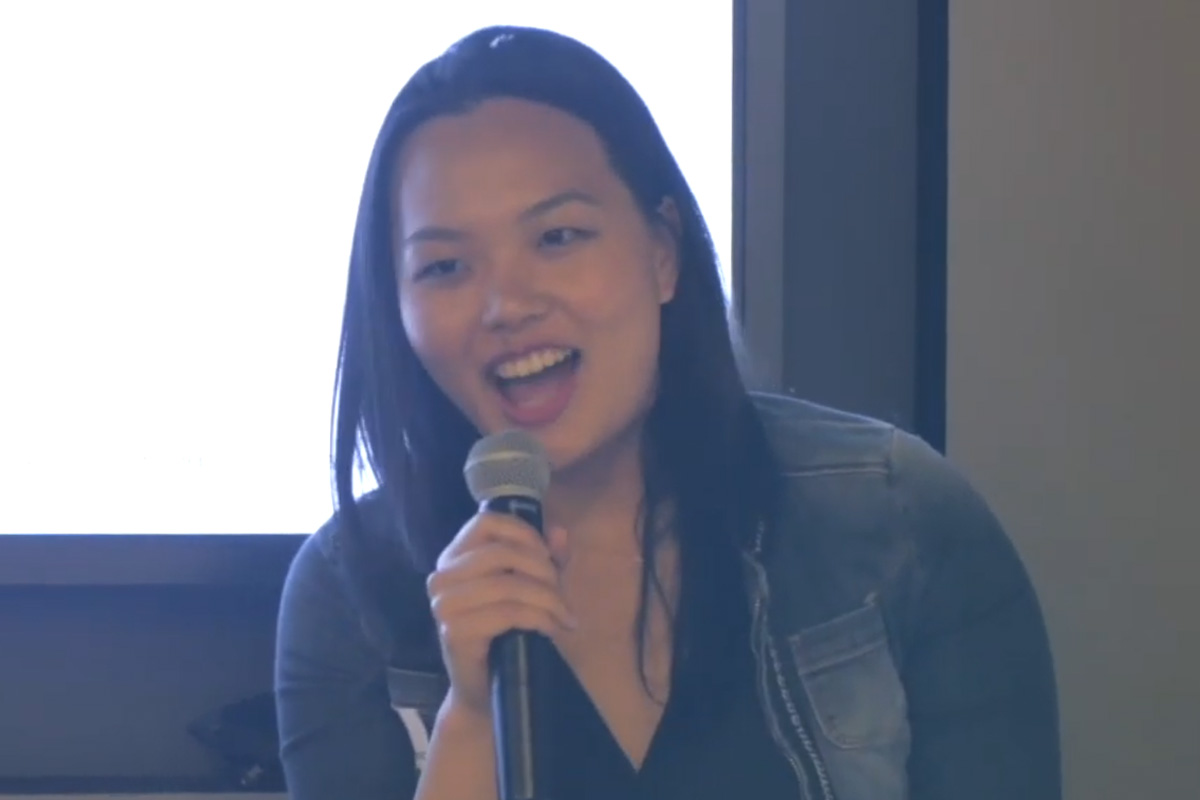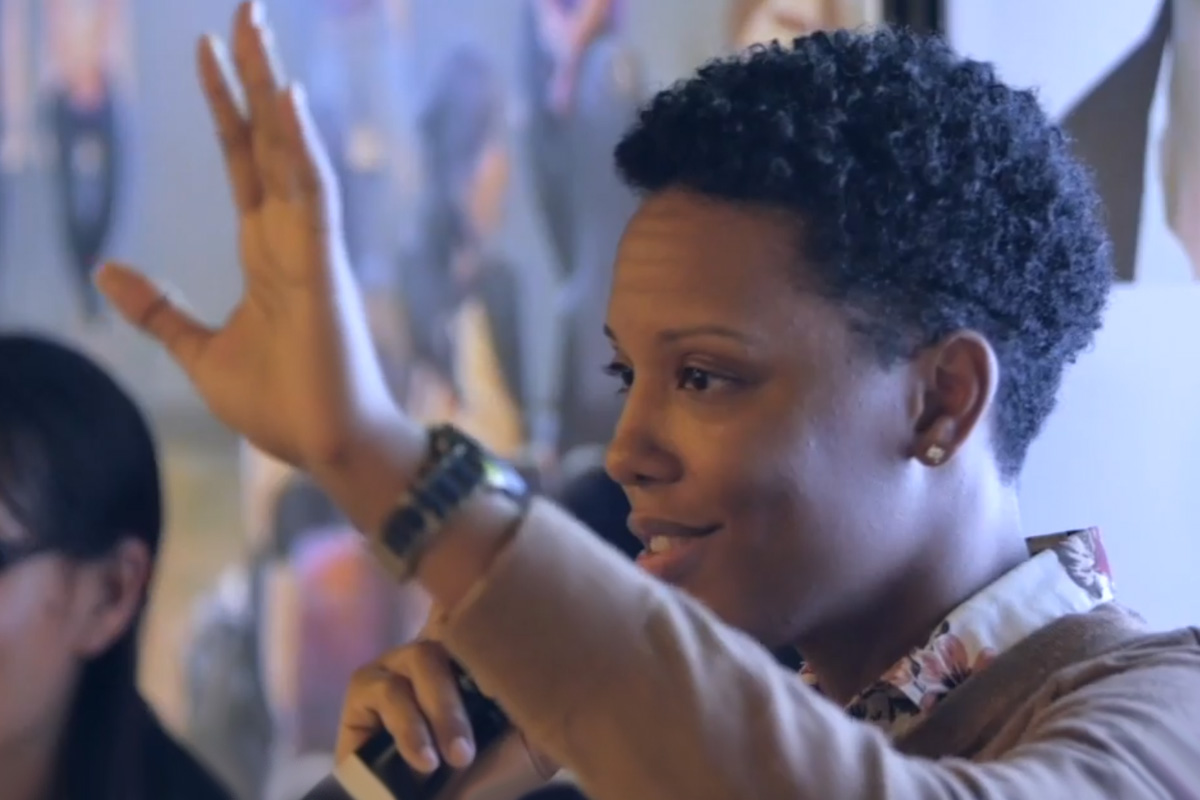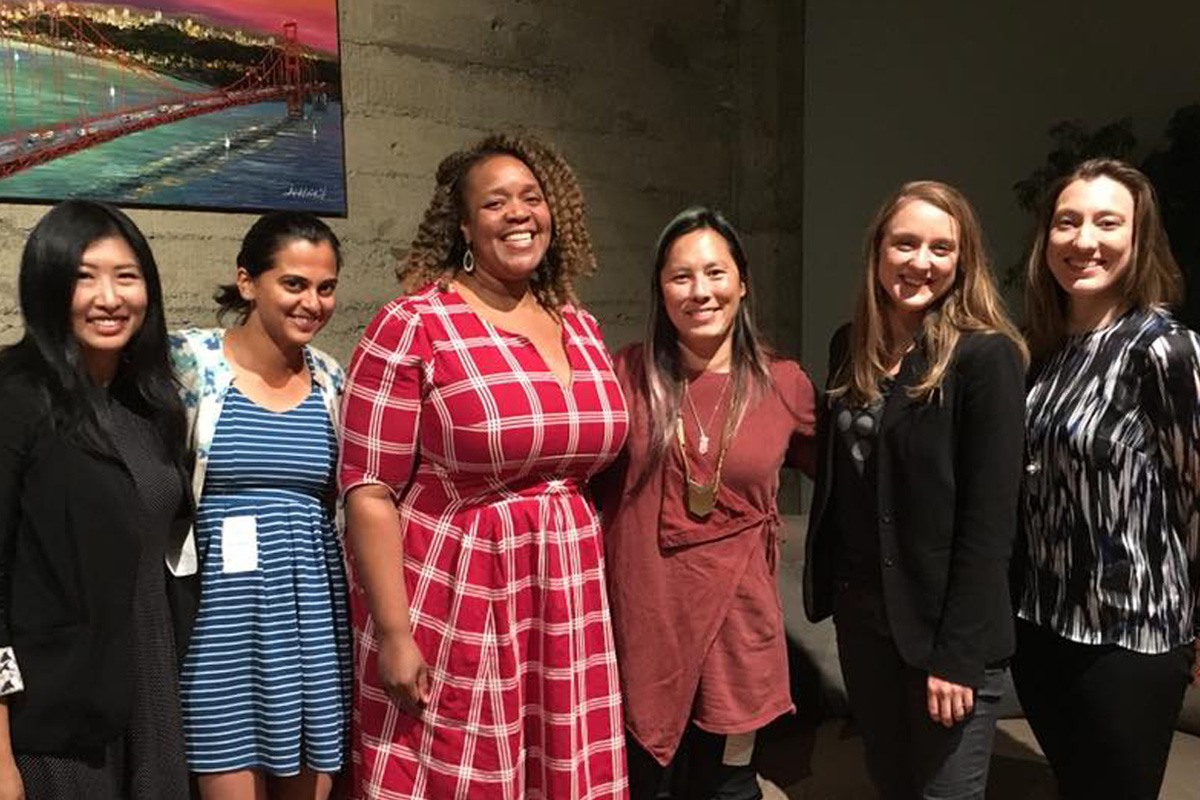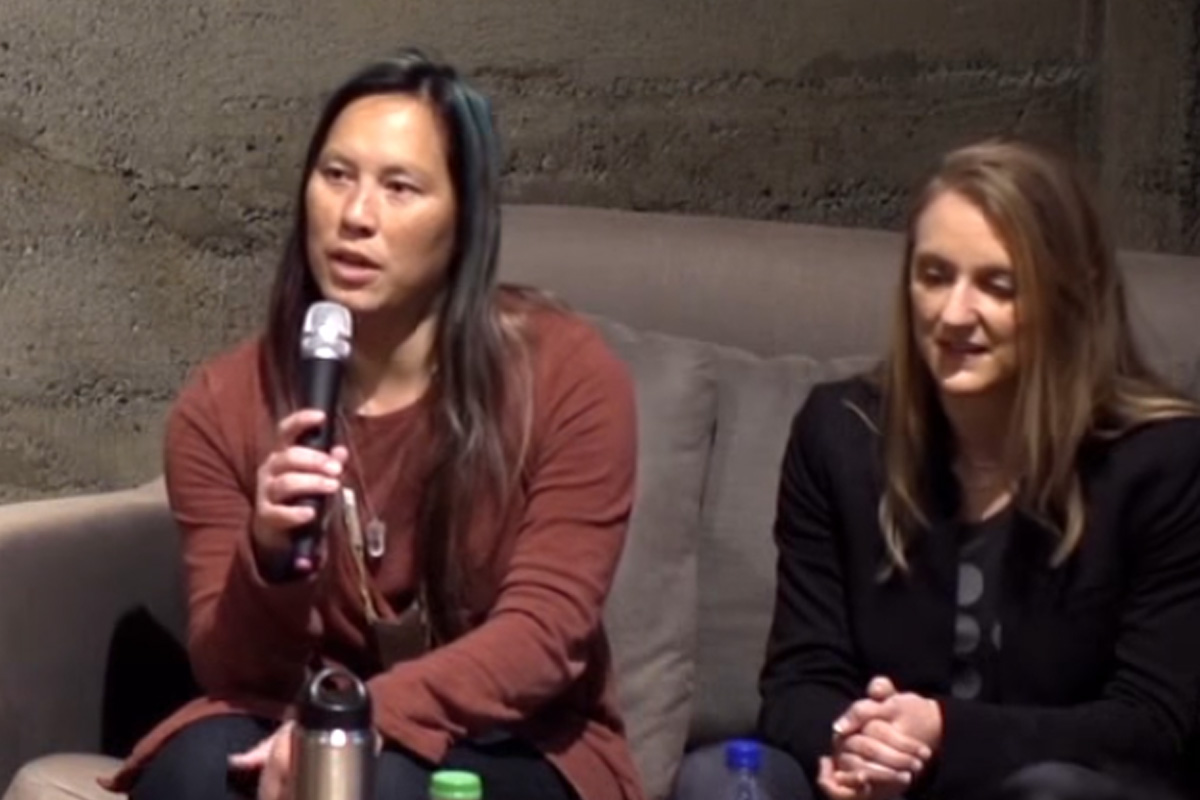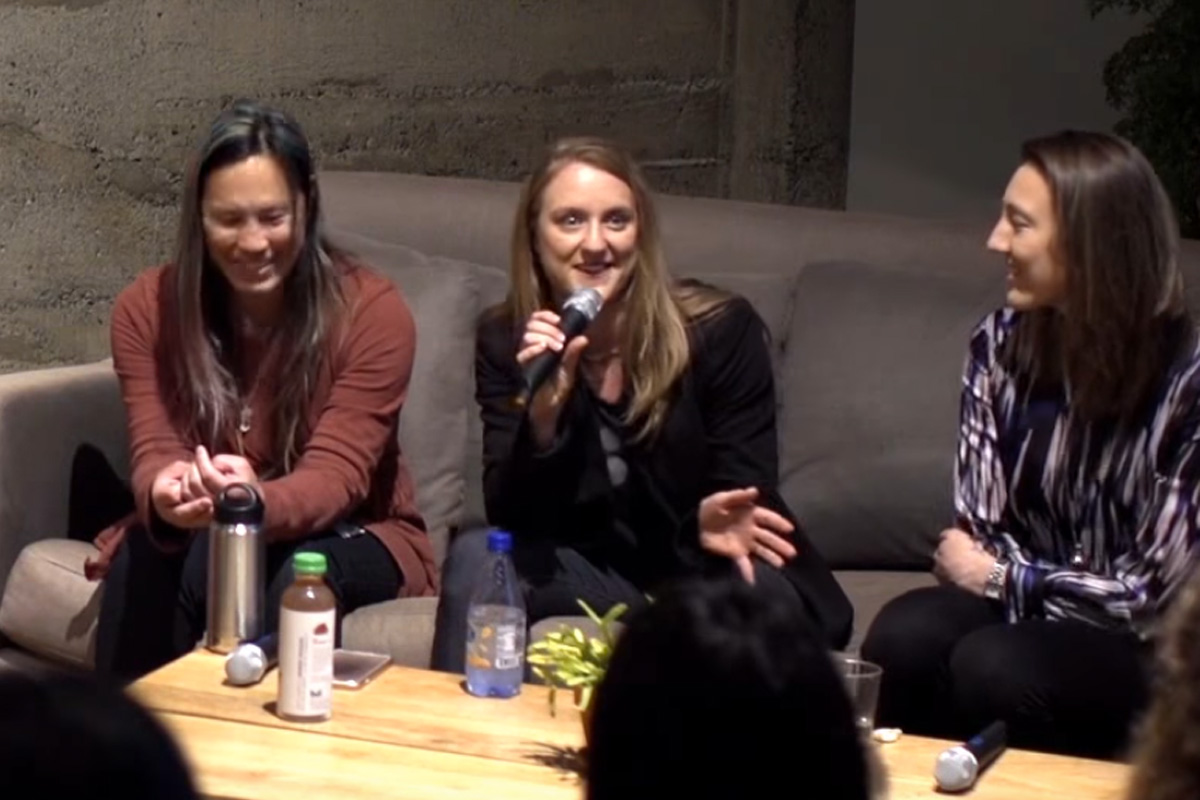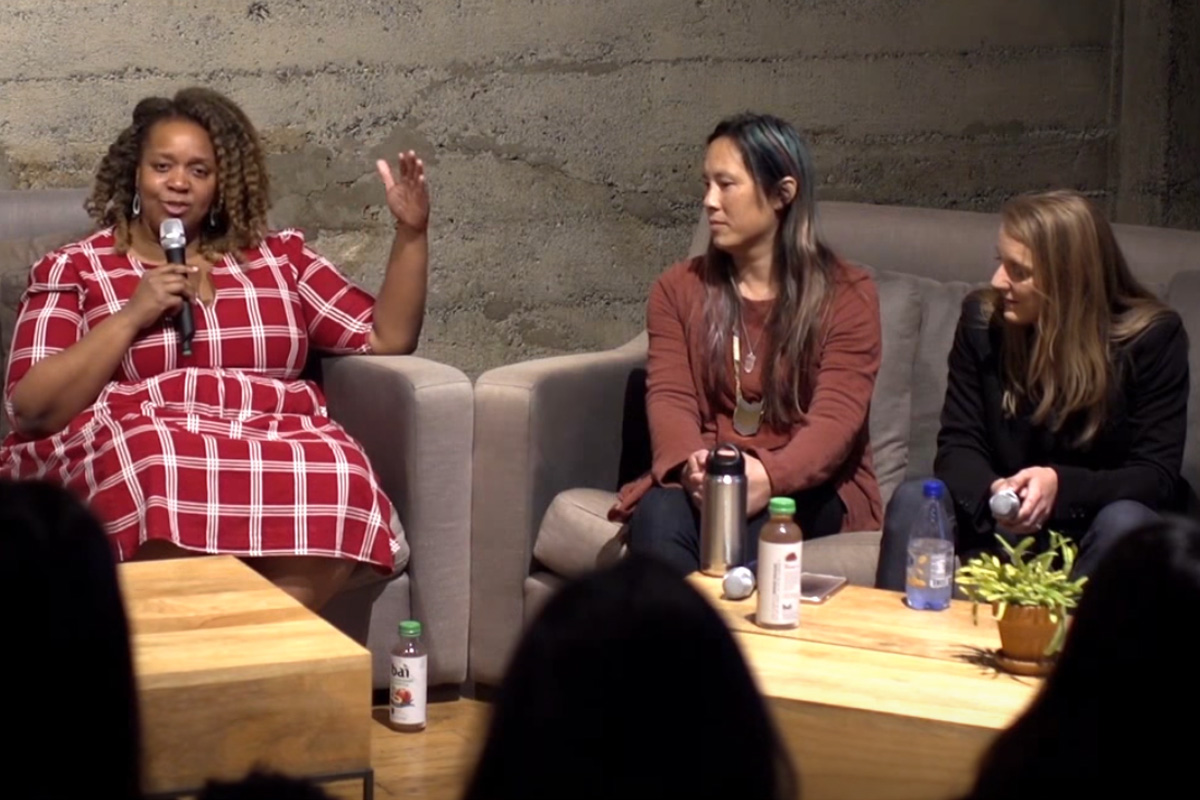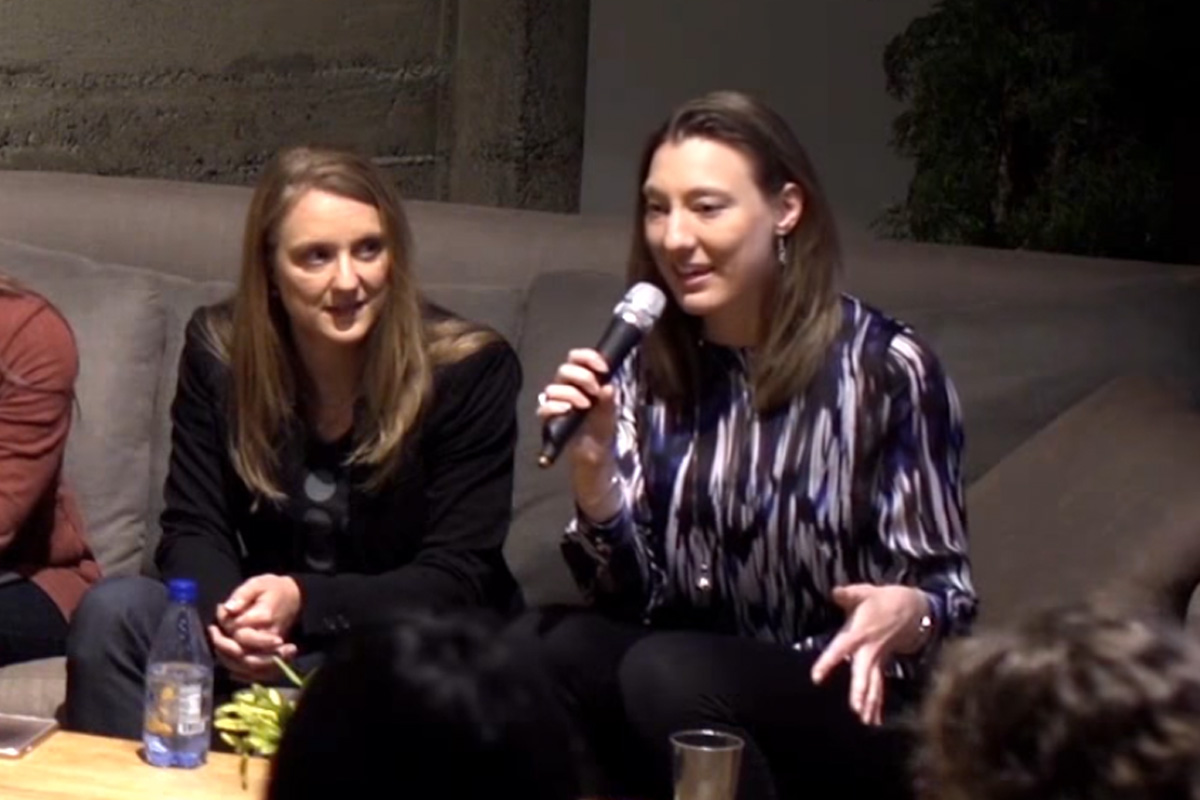Like what you see here? Our mission-aligned Girl Geek X partners are hiring!
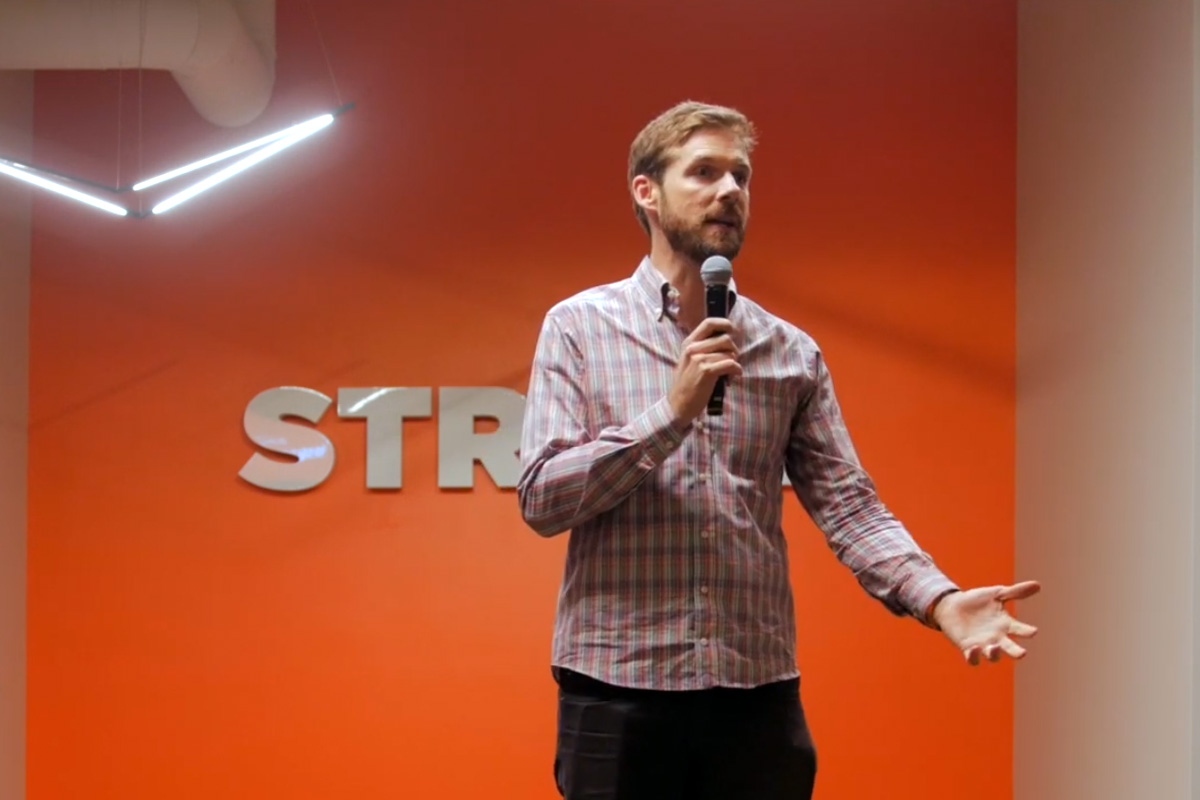
CEO James Quarles welcomes the sold-out crowd to Strava Girl Geek Dinner in San Francisco, California.
Speakers:
Stephanie Hannon / Chief Product Officer / Strava
Annie Graham / iOS Engineer / Strava
Cathy Tanimura / Senior Director, Analytics & Data Science / Strava
Amanda Sim / Senior Brand Designer / Strava
Harini Iyer / Server Engineer / Strava
Lia Siebert / Product Manager / Strava
Elyse Kolker Gordon / Senior Engineering Manager / Strava
Angie Chang / CEO & Founder / Girl Geek X
Gretchen DeKnikker / COO / Girl Geek X
Sukrutha Bhadouria / CTO & Co-Founder / Girl Geek X
Transcript of Strava Girl Geek Dinner – Lightning Talks:
James Quarles: Welcome to Strava. My name is James. I am Strava CEO. Incredibly thrilled to welcome Girl Geek here tonight. I hope everybody brought their running shoes. No, we’re not going to make anybody run tonight. We’re really excited for the program we have tonight. Please enjoy yourselves. Hope you get a chance to meet all the Strava team members who are here, and you get a chance to meet some of our great leaders. I would like to bring up now Angie Chang, the founder of Girl Geek, and a great partner in welcoming you all here tonight.
Angie Chang: Thank you. Hi. My name is Angie Chang. I’m the founder of Girl Geek X. We’ve been organizing dinners like this for over a decade. How many of you it’s your first Girl Geek dinner? Oh, wow. Okay. It’s about 40/50%. I’ll go into why we do this every week. It just thrills us to be able to put amazing and technical women on stage every week across different companies, encourage you to come in, eat the food, meet the people, meet each other, and also meet the amazing Strava engineers, and recruiters that are here tonight.
Gretchen DeKnikker: So, we don’t just do these events anymore. We just launched a podcast. So go to your favorite thing. Please rate it so that someone can find it at some point. We take little bits from each of the dinners, and then the three of us chime in with our opinions, because we have lots of those. And so, we’ve got mentorship, and imposter syndrome, and learning, and career transitions, and all sorts of topics that you can listen to on your commute. And then more importantly on March 8th, which is International Women’s Day–Mark your calendars–We’re doing a one-day virtual conference.
Gretchen DeKnikker: So, you can come tune in at your company, if you want. You could host a viewing party, which would be really awesome for you guys to do in this cool space. You could just join us all day. And it’s free, which is even better. And then if you want your company to get involved, definitely email us because we would love to have your company involved with it.
Sukrutha Bhadouria: Hi. That was Gretchen, who didn’t introduce herself. I’m Sukrutha. The three of us, we’re the team behind Girl Geek X. Like Angie said, we’ve been around for 11 years now. We went from one dinner of every few months to then once a month, and then now it’s once a week. It’s been an incredible journey so far. If you just went to our website, girlgeek.io, you’ll find links to the podcast. You’ll find links to our Elevate conference. I encourage you to sign up tonight for the conference because we want to make sure that we track who are signing up, and we give you the best experience possible because it’s virtual. It’s painless. You just need a strong network, and a computer or a phone, and you’re set.
Sukrutha Bhadouria: I want to just quickly explain what we’ve learned of the value of networking, and getting together, and why it’s so important for us to build this community. I’m sure a lot of you you’re just tired of being the only woman in the room sometimes, and it’s becoming easier and easier now to recommend women to work on your team with you if you were to just network, if you were to just make more friends.
Sukrutha Bhadouria: It’s really, really important to prioritize networking even before you actually need it. So build your network before you actually need it, and you’ll actually need it at some point. Because it takes a while to build a community that you need, and there’s so much you can do when you’re not alone. That’s all I have. Thank you so much for coming tonight. If this is your first dinner, like we saw a lot of you, we want to see you at all our dinners this year, at our conference. Please listen to our podcast. You just have to search for Girl Geek X on whatever podcast app you might have on your phone. Whatever you’ve missed so far, especially if this is your first time, you’ll be able to catch up. Thank you. I’m going to hand it off to Steph.
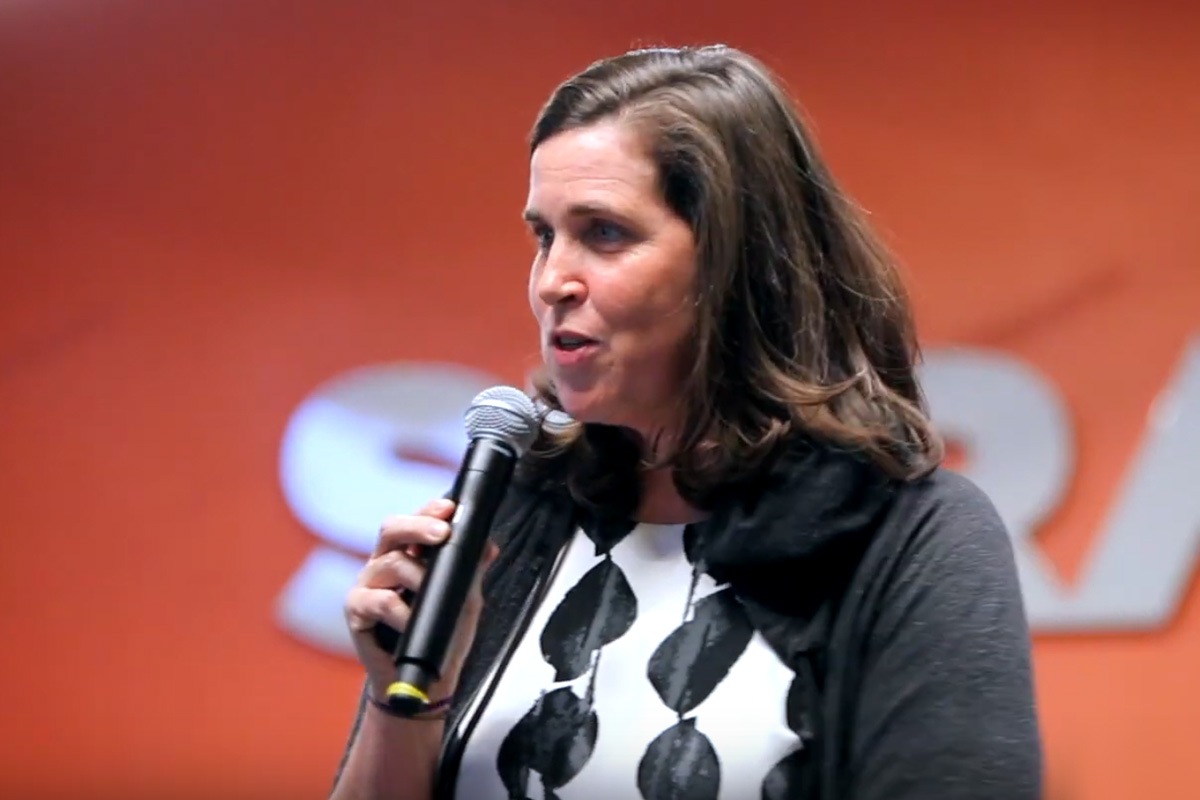
CPO Stephanie Hannon talks about the company mission at Strava Girl Geek Dinner.
Stephanie Hannon: Thank you. Hello. Good evening. My name is Stephanie Hannon. I am the chief product officer here at Strava. I’m so proud to welcome you here. We’re so excited to have Girl Geek X here in our new beautiful office space. Do you guys like it? Open. Airy. Room to run around. Room to do push ups and pull ups, which is normal, normal of course of business here. I think it’s really helpful to know who is here from Strava. So raise your hand. There’s a lot of people mingled, obviously, in the back. On behalf of them, I want to welcome you here. Raise your hand if you are a Strava user, for the visitors. Okay. Great. Oh, that’s awesome.
Stephanie Hannon: My job, I’m the emcee, is just to tell you a little bit about the company, and then get the lightning talks started. As many of you already know, if you’re Strava athletes, the origin of Strava is in this boat house. Our founders, Michael and Mark, used to row together. And when they left the boat house more than, I think, two or three decades ago, they wanted to create that same spirit of comradery and competition using technology once they were out of college.
Stephanie Hannon: It resulted in what we now have built, which is the largest, connected community of athletes, where every impact, every activity has impact. You’re going to hear that word athlete a lot today. Athlete or member of Strava. We consider anyone that is active an athlete. Whether you’re training for a marathon, or did the AIDS Ride, or if you just do yoga once a week, or if hiking is your favorite sport, you’re an athlete to us. So you’re going to hear that word a lot today.
Stephanie Hannon: We’re a 10-year-old company. We just had our anniversary. About 170 employees, and we’re in four offices: San Francisco, Denver, Bristol, and Hanover, New Hampshire. I’m just going to keep saying throughout the presentation we have a lot of jobs. You’re going to hear it from me now. You’re going to hear from me at the end, and there’s a lot of people here who would love to meet you if you want to talk about that.
Stephanie Hannon: Strava at its heart is digital motivation for athletes. These are screenshots of our products. Pieces of it are segments. So every bit of the world is divided into segments, and every segment has a leaderboard, and that’s been part of the engaging aspect of Strava. Memorialization, telling the story of your sport. Accountability and metrics to track, and then self improvement, which is either I want to perform consistently, or I want to get better. Just helping you achieve your goal or your summit.
Stephanie Hannon: That’s at the heart of what Strava is, but you’re going to hear a ton more about it through the lightning talks. Some of you might have heard, if you read the Eventbrite invites, that before Strava I worked for Hillary Clinton. In the 2016 presidential campaign, I was her chief technology officer. I often get the question about why I made the transition from that job into Strava. And so I thought for the first time ever, I’m going to tell you guys the top five reasons. So never before seen content. Even to my CEO over there.
Stephanie Hannon: The first is it’s a global product. Not many people know this statistic. 82% of our athletes are located outside of United States. To me, shocking number. It’s a really exciting number. We’re a 38 million community of connected athletes. 82% outside of the US, and that’s interesting for building products, thinking about if you just take runners, what is a runner in Rio like versus Copenhagen, versus Sydney, versus Tokyo, and how do you build a meaningful product that helps athletes all over the world is a really fascinating problem.
Stephanie Hannon: Mission. A lot of the work I’ve done in my life is mission-driven. I worked on disaster response at Google. Transparency in elections. Making public transit, a first order operation in Google Maps. Just things that have mission matter to me. Our mission is helping the world be healthy and active. And so much good comes from that in terms of longevity in life, but also in resiliency, and relationships, and emotions, and lots of good things, and the mission is amazing here.
Stephanie Hannon: Routes. So I spend a lot of my life at Google building Google Maps. I’m obsessed with routes. One of my favorite quotes in the world is, “Every route worth doing, has been done and uploaded to Strava.” Right? It’s a big statement. Every route worth doing, has been done and uploaded to Strava. There is no place you can run or ride in the world that we haven’t met. But we haven’t done, and you as our athletes, we haven’t done a great job of exposing that to you. That’s an amazing opportunity as a product person, as a builder. How can we make that discoverable and help athletes?
Stephanie Hannon: Platform. Again, in Google Maps, being a platform was a big part of our success. The ability for people to embed Google Maps in their applications, or to push data into Google maps. Strava is a platform, and these are just a few samples of the types of organizations we work with. Whether it’s a Garmin, where we can suck content from your Garmin watch into Strava, or Reliv, where data can be pulled out of Strava to create beautiful experiences, or the indoor studio. Wow, that’s a hard thing to say. Right, team? I’m not nervous. It’s the most number of people we’ve ever had in this room. I guarantee you, which is awesome.
Stephanie Hannon: But also, if you’re Peloton, if you’re a Fly, Mindbody person, we can also bring that content into Strava. Platforms are powerful, and they can scale with the innovation, and excitement that happens even outside of your company. And finally Metro. We believe we’re stewards of this amazing repository of community data. Metro is a part of Strava that works with cities. This is Copenhagen, and you can use aggregate data from Strava to see how traffic moves around your city.
Stephanie Hannon: For example, just whether there’s streets where a lot of people are riding without bike lanes. Or this example in Copenhagen, which is seeing how traffic changed once a piece of infrastructure, or a bridge was built. And that’s amazing. So if we do it well, cities have more infrastructure for cycling, cycling is safer, more trails, more green spaces.
Stephanie Hannon: So I hope I’ve convinced you, or explained to you what’s magical for me about this company. These six women are going to give talks. What’s exciting is it’s women in all different stages of their career. Some in their first year out of college, some who are in their second decade of work, people who work in data science analytics, engineering, brand design, and product management, so across different functions. And they all have different stories to tell you. I’m just really thrilled to get this started.
Stephanie Hannon: Finally, after the six talks, there is going to be Q&A and a panel, and all of us will be up here. I’m just putting this up now. I’ll put it up again at the end. I think with a group this big, it’s nice to crowd source questions, and let you guys vote on each other’s questions, and that’s what you can do with Slido. It’s GG Strava. Any time during this event, you can go and add your question. If you don’t have a question, but you want to vote on questions, you can also check out that URL. Let’s get started. I’m going to bring up Annie.
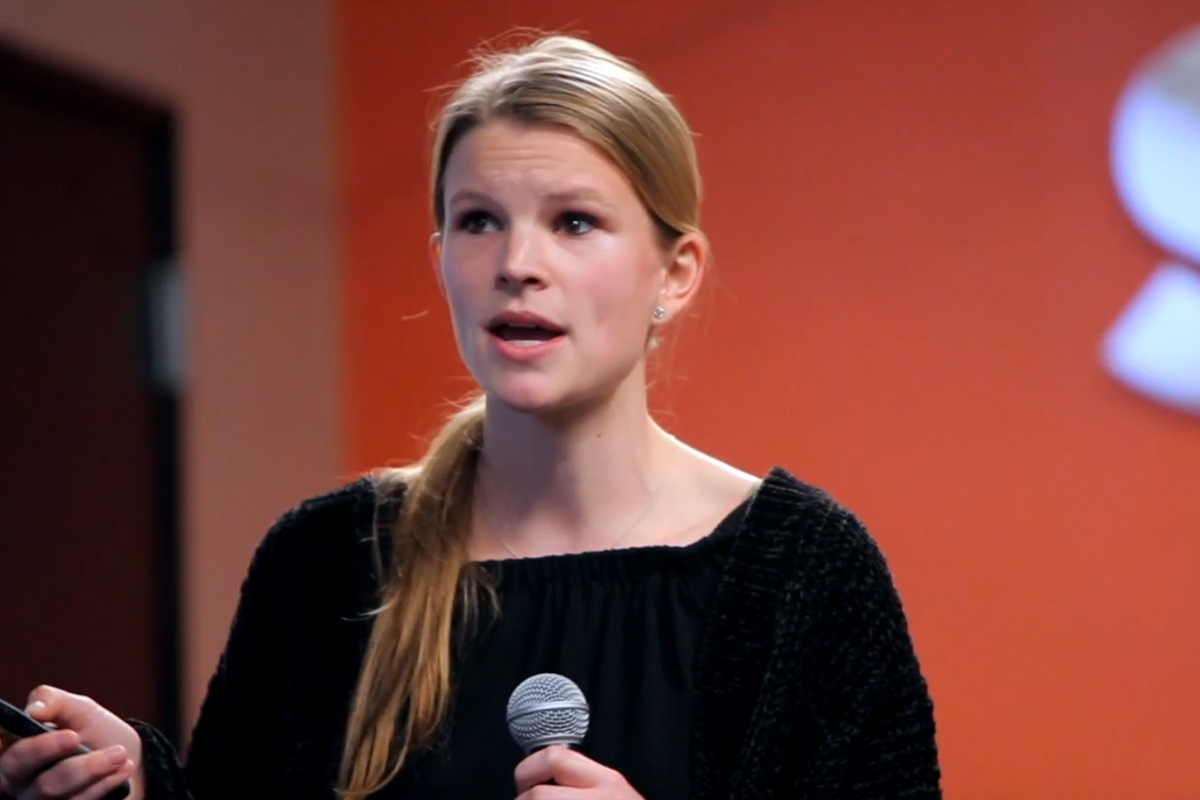
iOS Engineer Annie Graham gives a talk on “Growth Engineering Beyond Metrics” at Strava Girl Geek Dinner.
Annie Graham: Hi everyone. I’m Annie, I’m an iOS engineer on the growth team. I’ve been at Strava since this past October, plus an internship in 2017. Today I’m going to talk to you guys a little bit about what brought me to Strava, and also about growth team culture at Strava. So, I just graduated from Stanford in June, and at Stanford I majored in symbolic systems, which I’m destined to explain for the rest of my life means that I majored in kind of a mix of psychology and computer science. Within that, I concentrated in human computer interaction.
Annie Graham: So, within that kind of general realm of interest, I worked in a health psychology lab as a research assistant. My work there really got me interested in this question: What is the psychological power and impact of health related user interfaces? My passion and interest in this subject made me really want to work at a health tech company with a big user facing side. That’s what brought me to Strava as an iOS engineer the summer before my senior year at school.
Annie Graham: When I returned to school, I wanted to keep exploring this field. So I worked at a company called Lark as a health psychology content consultant. Lark is basically a health coach chat bot in an app on your phone. And so, I wrote content for conversations like these with users who were struggling with diabetes or hypertension. And then, after graduation, I returned back to Strava as a full-time iOS engineer. If you’re wondering how I feel about being back at Strava, this picture pretty much sums it up.
Annie Graham: This is me running in our J.P. Morgan Corporate 5K. Yeah, this really says it all. I love Strava. It’s been such a fantastic experience working here. We are hiring. Now that you guys know a little bit about me, I’m going to talk some about growth team culture at Strava. Maybe it’s helpful to talk about what the growth team means at Strava. We really focus on bringing users into the product, and also on the new user journey. So users for seven days in the product.
Annie Graham: For us, growth team culture really revolves around these two themes of inclusivity and empowering experimentation. So, what do I mean by inclusivity? We’re very inclusive of both ideas and people. And that comes across in many ways. Through the way we do brainstorms, the way we think about our users, and also who we give task ownership to on the team.
Annie Graham: So, our brainstorms are very inclusive of different roles on the teams. When we have a kind of an idea of a project we want to pursue, we get engineers of all different levels, designers, and PMs in the same room. Although the quality of our sketches are not always equal, the ideas are hopefully always taken equally seriously. It’s a really collaborative environment. There are no vetoes in this room, and it’s really all about cultivating that creativity, and collaboration. I’ve definitely found that getting all these different perspectives and roles in the same room, the whole is much greater than the sum of the parts.
Annie Graham: Next. User perspective. So, on the growth team we have this mantra. I am not the user. We repeat this a lot. It helps us keep front of mind the fact that I use Strava in a much different way than the typical user, especially the typical new user. And therefore, I should build with that in mind. I should not be building product for myself.
Annie Graham: Finally, task ownership. You don’t have to have been here the longest, or to have the most experience to own tasks on the growth team. Within my first two weeks of being here, I got to build this feature where you can post a sticker of your activity to your Instagram story. Now, as you can imagine, I tested this feature a lot over the course of my building it. I was posting an inappropriate number of runs to my Instagram, my personal Instagram story, which resulted in quite a bit of confusion on the part of my friends. I received a lot of DMs like these.
Annie Graham: Now that I’ve talked some about inclusivity, I’m going to move on to this idea of empowering experimentation. Experimentation is a really common thing on a lot of growth teams. But at Strava, I’d like to say we have a particularly “test it” culture. That means that no matter who you are on the team, if you’re excited about an experiment idea, and if there’s plausible reason to believe that it will positively impact one of our core metrics, we really encourage you to run with it.
Annie Graham: I think that’s evidenced by the fact that we actually set aside quite a bit of time to allow people to run with it. The day before Thanksgiving, there’s in the kind of smokey haze that I’m sure we all remember. My fellow engineer on the growth team, Tim and Elyse, who you guys will hear from in a second, declared it a mini experiment’s day. They said you can run today. You can take the day and run whatever experiment you want to as long as you follow these guidelines, collaborate with design, target a specific metric that we care about, and don’t take more than four hours or so to build it.
Annie Graham: I went ahead and created this super simple copy change where I changed the text on the follow button to say follow back if that user already follows you. This was really small. It was only a few hours of work, but it resulted in a huge lift in the overall follows on Strava, which is really exciting. I think this is a super cool example of cultivating creativity at all levels of the team, because after we knew about the potential here, we put in additional resources into this same idea, and one of the data scientists work with a senior engineer on the team to create a machine learning version of the same test that has recently gone live, and also had extremely positive results.
Annie Graham: And so, that’s a cool example of how this empowering experimentation culture can really result in a very cool momentum. This culture is not exclusive to the growth team. We also, here at Strava, have something called Jams. So four times a year we set aside three days for basically a company-wide hackathon where everyone can work on whatever they want to that they’re excited about related to Strava for three days. It’s a really cool chance to switch up the pce of things, and also collaborate with people that you don’t usually get to work with.
Annie Graham: So for the most recent Strava Jams, I created yet another quite simple test. I put a country flag emoji on the bottom of user’s profile pictures. Now, this was not quite as much of glaring success as the follow back test because it turns out our backend does not distinguish between Northern Ireland and England. Which meant that about 16 hours after this went live, we were experiencing quite a few angry support tickets from Irish users wondering why Yours Truly had put a union jack flag on the bottom of their profile pictures. That just goes to show that I am not the user. Thank you so much. That’s it.
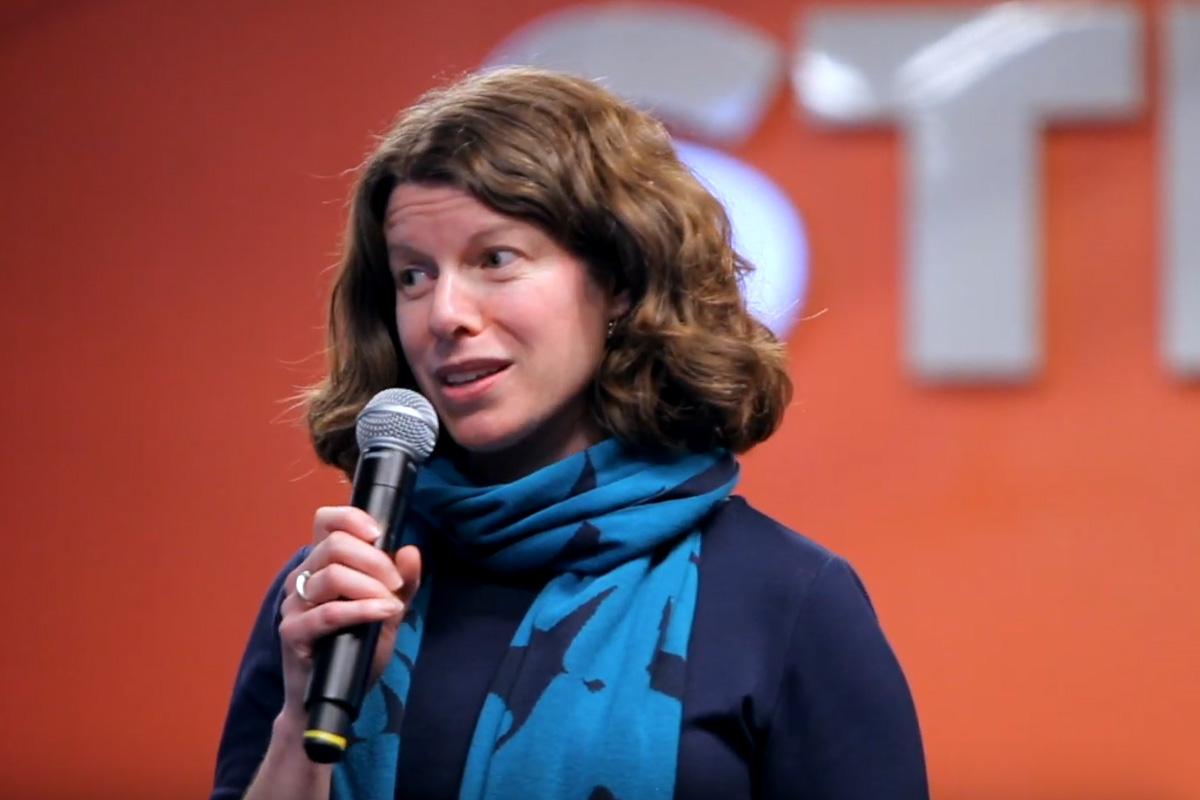
Senior Director of Analytics and Data Science Cathy Tanimura gives a talk on “Data + Scale + Community = Impact” at Strava Girl Geek Dinner.
Cathy Tanimura: Thank you, Annie. Hi. I’m Cathy Tanimura. I’m Senior Director of Analytics and Data Science here at Strava. I’m going to talk to you about how data, scale, and community allows us to make a really outsized impact. So a little bit about me, I’m a big data geek. Didn’t use to be a cool thing to say, but I feel like I’m in good company here. I’ve had a chance to work on some really interesting data sets across my career. I was at StubHub, where I got to work on sports and concert ticket data sets. I was at Zynga working on games, social interactions, lonely cows, if you remember those. I moved to a company called Okta, worked on a lot of security, B2B app marketplace sort of data. And now I’m at Strava, where I’ve been for the last year or so.
Cathy Tanimura: I get a lot of questions, why Strava? In addition to the culture and the people, which I love, for me it’s really about the data. Let me tell you about the data. In this big data space, which has 3Vs that we talk about, so I’ll just walk through them. First is the volume. How much data do you have? As Steph mentioned, we have 38 million members. We’ve had over two billion uploads. 6.7 billion miles of activities in 2018 alone. That’s a lot of sweat. And over 90 million social interactions per week.
Cathy Tanimura: Second V, velocity. There’s a lot going on. We have about 20 uploads per second. We’re a global community, which means it’s always time for a preferred activity somewhere. We like to call them preferred activities. If you don’t know what that is, we support almost 40 of them, everything from alpine skiing to yoga, in addition to cycling and running, of course. And finally, variety. This was what really sold Strava for me.
Cathy Tanimura: With our global community of athletes doing lots of activities, we have all sorts of different data sets within the broader scope. Geospatial, longitudinal, people training over time, social, global, as I mentioned a few times. We have In-app interactions to look at. We have a subscription business. We have platform integrations, health and fitness. But most of all, the data is really about people doing what they love, following their passions, striving toward the goals that really motivate them. That’s just a really cool interesting dataset to work with. We do all this with a relatively small team.
Cathy Tanimura: I’m going to walk you through a few examples of the impact that we’ve made so far, and things we’re thinking about. First I’m going to talk to you about motivation, and some of the work our analytics team has done in this space. So, we’ve been able to do some really interesting work thinking about how and when … One of the things we found in all of this, technology space, there’s a lot of devices. There’s a lot of apps. But what really motivates people is the people.
Cathy Tanimura: So, it’s the people that you connect with. It’s the people who support you. It’s the people who motivate you to get out of the bed in the morning. We’ve been able to do some really interesting work around this. A few findings we had, people who do activities with other people spend more time doing them. They also go further. So, having somebody there with you helps you go for that longer run. Go for that longer run. Get out of bed in the morning when it’s cold, and you might not feel like doing that.
Cathy Tanimura: The next impact I want to talk about is inside of our walls, and our core engineering. I want to tell you a little story about Strava segment leader boards. For those of you who aren’t as familiar let me give you a quick intro to them. We have this thing called Strava segments. They’re member created portions of road, or trail, where athletes can compete for time. So you do an activity. This is an example of mine where there’s a segment that’s a portion of Golden Gate Park, where I like to ride.
Cathy Tanimura: When you upload your activity, we calculate the amount of time it takes you to cross that space. An activity can have multiple segments. So I ride from here to my home in Outer Richmond. I cross lots of different segments. We calculate your time for all of those when you upload. I should mention we have over 15 million segments all over the world, tens of billions of efforts across all of those segments. So it’s quite a lot of data.
Cathy Tanimura: And then we place that effort onto a leaderboard. We do this while you’re uploading. People like to go upload, then go check their placement on that leaderboard. I’m not particularly fast, but it’s still fun to see how I stack up. I tend to go to the most finely sliced leaderboard where I might actually show up more than a thousand. But it’s quite an honor to be in the top of the list. If you are top of number one, you get to be that king or queen on the mountain, and it’s quite an honor.
Cathy Tanimura: This all works great. This has been a really important feature that people love. It’s all well and good until we get an event like RideLondon. For those of you who don’t know, RideLondon is a huge cycling festival put on by the City of London. It has a number of different events. It has some pro events. It has some amateur events. Tens of thousands of people compete across these events. Lots of them are Strava athletes, which is fantastic. And they do their activities, and they upload, and they go to check their leaderboard. This reliably brought down Strava for a number of years, not a great place to be.
Cathy Tanimura: And so, some of our engineers decided to go and fix this problem. Just for some history on how this feature was implemented, way back in the day this was one of the original Strava features. SQL queries were how they were built. I love SQL queries. I’m a data geek, but these don’t really scale. From there, we moved into an architecture leveraging Redis and Scala, which worked for a while, but ended up with some hotspots, outages when we got lots of people uploading at the same time like an event like RideLondon.
Cathy Tanimura: The work was then to move it to a more modern architecture where we’re using Kafka for streaming, Cassandra for the data storage behind the leader boards. At our scale, we really needed to have an architecture that could support thousands of data points per second, again, across tens of billions of data points. We have a whole series of posts on our engineering blog, which I’ll encourage you to go check out if you’re interested.
Cathy Tanimura: This is such a big accomplishment that even our marketing team got excited about it, and made a public announcement. Hey, Strava stayed up! We had 15,000 people uploading from RideLondon in 2017, also stayed up in 2018, which was fantastic. And then the final area of impact I want to talk about is around discovery. So this idea of we know all these segments. We know these places in the world people are active. How can we help people discover them? How can we help people stay motivated to go somewhere new to do something fresh?
Cathy Tanimura: We’ve done some various data science projects around this. We become well-known for a classic Strava heat map. You can see where people are riding and running in the world. One of my goals this year was to do some open water swimming. I was very excited to find that Strava heat maps works for swimming too. A lot of swimming going on in the bay. It’s been pretty cold out lately. Does anybody notice that? Not really when I want to jump in aquatic parks. How about Hawaii? I know that Waikiki Diamond Head area looks a lot more appealing at this time of year.
Cathy Tanimura: We think this is great. But how can we push this further? How can we help people really find specific routes in the world? Places to go that are new, that are different, that have the right profile of trail? Things that they’re looking for? And then beyond that into workouts, into devices, even into virtual workout space like Swift, all sorts of interesting opportunities in the space. So stay tuned. Just to wrap it up, talked about our data, our scale, our community, and how we really think this work allows us to make an impact on our athletes, our partners, our communities, and our teammates, really every day, which is has been super exciting for me. Thank you.
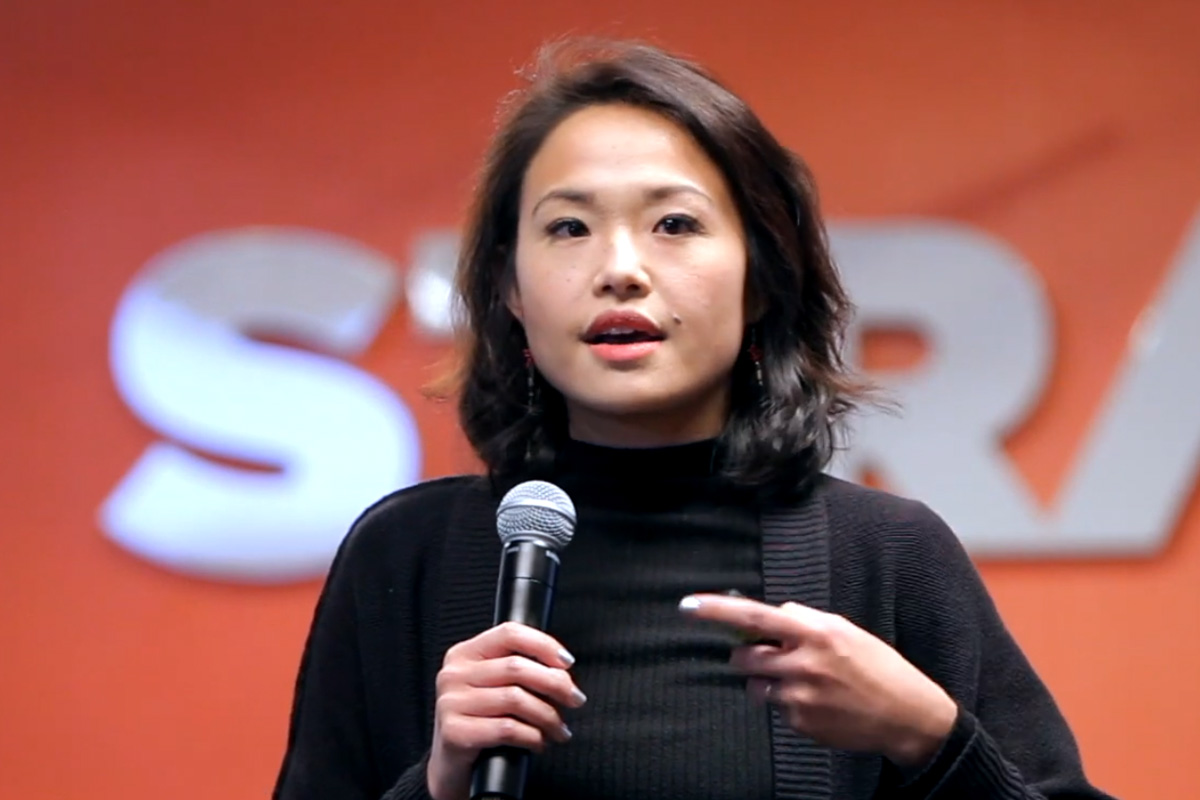
Senior Brand Designer Amanda Sim gives a talk on “A Brand for All Seasons” at Strava Girl Geek Dinner.
Amanda Sim: Hi. Thank you all for coming. Here we go. I’m Amanda. I’m a brand designer here at Strava. I’m just going to talk a little bit about what it’s like being a brand designer, and particularly an in-house designer. You’re okay?
Audience member: I’m sorry.
Amanda Sim: Okay. Bless you. Jumping in, I have identified and boiled down what I think are the two things that make up a really winning brand design. The first one is what I call a household name. It’s when people can quickly recognize your brand in the wild. That’s like you see a logo. You see an ad or a billboard, and you immediately know the company. Even better is you hear the name on the BART and you know it without seeing anything. That’s like that quick recognition.
Amanda Sim: The second component of the winning brand design, I think, is what I call the chocolate factory. I want to caveat this and just say these are not industry terms. The chocolate factory is that positive association with your brand. Even better, it is anticipation and engaging with your brand. It’s those quirky moments. I think of it like the Willy Wonka chocolate factory where there’s that delightful surprise around every corner, and you can’t wait to get there.
Amanda Sim: The thing about these two qualities that make up a winning brand design is that they’re naturally at odds with one another. The household name requires a consistent familiarity that makes you comfortable with that brand. It makes it feel credible and reliable. But the chocolate factory quality is what keeps it exciting, and keeps it churning. It’s like you turn a corner and you’re licking wallpaper, and then you run around, and you’re jumping into a chocolate fountain, and it keeps you coming back.
Amanda Sim: I’m just going to rewind a little bit, and give you a little bit of insight. I didn’t know what to call the slide so I figured Amanda was an apt title. I’m going to give you a little background about me. I’ve had a pretty varied design background. I started out actually as an analog print maker making posters, wood cuts, lithographies, and etchings. From there, I was an architectural brand designer. What that meant was before a building was built, I would design the branding for it.
Amanda Sim: And so, in the five years that it took for a structure to go up, you could get some marketing out there, some anticipation, some hype about that place, whether it was a residential place, or maybe a new building on a school campus. There were a lot of different clients. It was like a lot of different stakeholders. A lot of different types of buildings, little brand projects.
Amanda Sim: From there, I actually went to co-found a product design company. Not a digital product, but a physical product. The company was Eone timepieces. We made timepieces for people who are visually impaired. As a co-founder, I led marketing, brand identity, and the visual design. And then went on to a traditional design agency called Stoltze up in Boston. I did everything from the Bright Horizons, signage outside of a daycare, to the dental convention is coming to town and someone has got to design that brochure. Again, a lot of different stakeholders.
Amanda Sim: And then I was a book designer, actually, just around the corner at Chronicle Books. There I did lifestyle books, self help books. I did a lot of cat calendars. That was really big when I was there. Again, it felt like a lot of different clients. For every manuscript, for every author, you needed a new look and feel.
Amanda Sim: After that, I went into design consulting at agency called IDEO. They’re located headquartered in the Bay Area. The work there was incredibly conceptual, really feature facing. I mostly dabbled in full environmental build outs. So hypothetical build outs in retail, in automotive, and in medicine. So, really exciting, fertile work. But again, a lot of clients. And that brings us to the present day.
Amanda Sim: How did I arrive at being an in-house brand designer? When I looked back on my full career, I did this little blink. I noticed that a lot of my work was in consulting. And so, what that meant was a huge breadth of work. But I didn’t really get to go super deep because a client–essentially as a consultant, they would come up to me, tell me a little bit about their company. Maybe push some brand guidelines toward me, and then it was my job as a consultant before Strava to come up with some designs, make some suggestions, present it, and everyone is like, “Wow, that’s so shiny and new. I love it.” And I be like, “Peace.”
Amanda Sim: And then the in-house designers would have to like pick up all the pieces, and then quickly scramble to try to figure out how to make sense of it. I felt like it was really love them and leave them. I was having a blast. But I really wanted to see how my design could be implemented, get out into the world, what the feedback was on that, and then how it could evolve into something else, or how it would change over time.
Amanda Sim: And so, bam, Strava. I came to Strava in-house. For me, this was a huge move. It was a little like settling down. So Strava made me some promises, and then I was like, “I’ll honor, respect your brand. You can trust me.” So far it’s been really good. So, as soon as I was hired, I kind of jumped into it. This is like a little delayed. I jumped into it with the same intensity and fervor that I had done the decade before in consulting.
Amanda Sim: What that meant was like I was like, “It’s going to look like this. It’s going to look super cool. We’re going to use motion this way.” This is a little vignette of my first few months at Strava. A lot of really fun and engaging visuals. I felt like there was something for everyone, a little nugget that people could grab on to. I think that the work was really fun. But when we took a step back, we noticed we were really squarely over indexing in that chocolate factory excitement.
Amanda Sim: We were missing a lot of the balance that pushes a good brand to become a great or extraordinary brand. One where, yeah, you’re getting all those shots of endorphins when you see something new, and you want to engage it. But there’s that reliability, and that consistency, and that familiarity. And so, the last … I’ve been here a year plus now. I would say that we’ve been working really, really hard to bring that visual consistency, that strength of brand, that awareness, to all of visuals that we have done–this is just the last few months–without losing that nugget of something really interesting, and good, and juicy.
Amanda Sim: And for me, that means like in-house has a really apt name. I stepped back and I was like, “Why do they call them in-house designers?” I was like, “Oh, I get it now. After this presentation, I get it.” I think that it’s called in-house because when you join a company, a house, a home, you are tasked with being a part of that place as the brand designer. It’s not your job to tear down walls, or relocate bathrooms, or decide that you want a sunroom, or outdoor sauna.
Amanda Sim: But it is your job to keep things interesting there. To make a house, which is a company, into a home, to paint the walls, or bring in pictures. At the end of the day, you want it to be in some place that is welcoming, that is reliable, but you also have the liberty to bring home the occasional Oompa Loompa. Thank you.
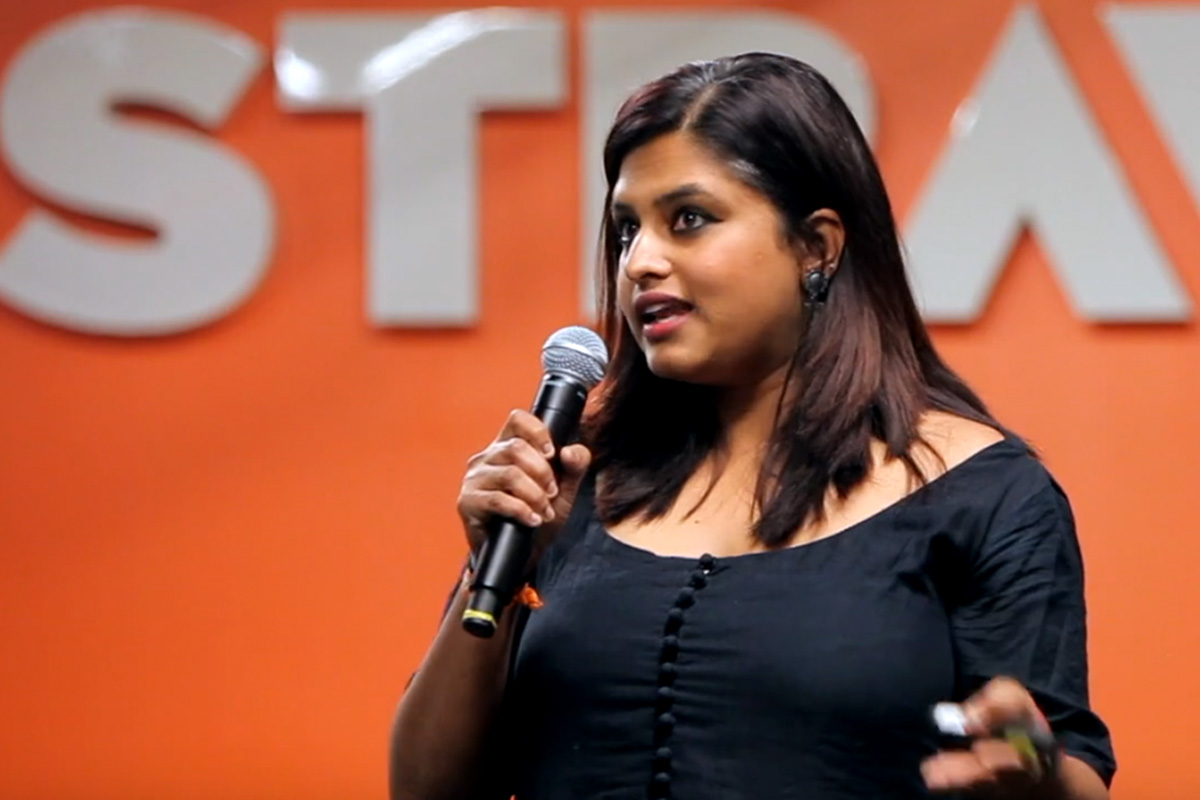
Server Engineer Harini Iyer gives a talk on “Performance at Scale” at Strava Girl Geek Dinner.
Harini Iyer: Oh. That orange totally disappeared. And we’re video taping, and I am extremely dehydrated. Hello everyone. I am Harini Iyer. I am not an athlete. I derive joys from a lot of things in this world, and it doesn’t involve GPS or any movements, really. The last time I ran was when I was 22 when I had to run away from my home to come this country to escape getting married. That was pretty much the last time I ran away from anything, and the last time I ran. Too bad Strava wasn’t a thing back then.
Harini Iyer: Anyway, the only time I really use Strava is times like these when I’m thrown on the stage, and I have my heart in my mouth, and I have to record my heart rate. What do I do at Strava? I am a server engineer. I joined Strava about a year … A little over a year ago. I work on the performance improvement initiative, which is what this talk is about. Before that, I want to tell you a little story.
Harini Iyer: I grew up in India. Back in the ’90s, when I was schooling, we used to get about two and a half months of summer holidays. It was very common for us to travel around the country. That’s what pretty much every other kid was doing. The only mode of transportation back then was trains. I grew up in a time when there was no internet. And probably the only thing worse than saying that is saying I grew up in a time when there was no fire. No, I did. I grew up in a time when there was no internet.
Harini Iyer: So we had to go to these ticketing offices, and we had to buy physical tickets. My dad used to wake me and my sister up at like 4:30 in the morning, and he’d drag us to this ticketing office. The first thing he’d do is he’d scan the room because there are too many people there trying to get hold of best tickets possible, the best seats. He would compute something. He would think about what are the fastest? What are going to be the fastest moving queues really? He was three children short of totally avoiding the computation, but he had to do it.
Harini Iyer: So, he would pick three queues, and we’d be standing in all the three queues. What I realized when I was writing this talk is I was taught to basically optimize very early on in life with limited resources because you’re always going to be short of resources. Flash forward to last month when I was in India, and now my dad is retired, he has this fancy phone with all the apps there. He holds me responsible for the performance of every app.
Harini Iyer: He keeps complaining about, “Oh, you know what? This is so slow.” I’m like, “What hurry are you in? Where are you going?” But the fact is technology has evolved, and with that, we have evolved. Our expectations have gone up. Patience has gone down. There is low tolerance for bad content, and there is absolutely no tolerance for slow content.
Harini Iyer: So, performance is a problem for every internet company today. At Strava, I hope it’s a simple product for our athletes. But for our engineer here, it’s a pretty complex product, right? So every time an athlete does a physical activity and he or she uploads it to Strava, it becomes a Strava activity. Strava activities are the building blocks of this product with our athletes at the center. So why is Strava concerned with performance?
Harini Iyer: Back in 2010, we didn’t have that many athletes connected to us. We didn’t have that many activities. Our data stores were small. We had a handful of engineers working on it. So performance was not a concern. But in 2017, we hit the one billion mark, and in 18 months, we hit the two billion mark with our activities. And we’re growing exponentially since then.
Harini Iyer: So, performance may not be an immediate problem for us, but it will be eventually. We want to proactively tackle that, which is why in the year 2019, it’s our objective to improve the performance of our app. It’s a complex product for an engineer. We had to have at least one focus area that we could start with. We decided that it’s going to be our feed, and we started to focus on the feed. Improving the performance of our mobile feed, to be precise.
Harini Iyer: The logical next step was have good instrumentation. So we started auditing what instrumentation we have in place. We added more instrumentation. We plotted more graphs, which would help us identify the areas in our system which are slow. It’s such a powerful tool, right? It’s a bearer of good news and bad news. But more importantly, it helps us in proactively monitoring if our performance is going down. Once we identify the slower parts in the system, we would then use the different tools we have to profile those parts of the system.
Harini Iyer: You’d find different problems, and we’d solve it with the hope that it improves the performance. For example, one of the things we found is this query. It’s [inaudible] where one equal to zero. Now, from those who are not familiar with SQL — you lucky people — what this means is, what this means is, give me data from this table where apples is equal to oranges, or sun is equal to moon, or something totally ridiculous like that. It’s a useless query. It’s not going to return any data. But we did find it in our system.
Harini Iyer: Now, I come from a darkness C-sharp world where an engineer has to literally put this query in the data layer for this query to exist. So I’m on a hunt. I’m looking for that one engineer who has inflicted this query on the product. But the fact is that it’s active record. When you do a data model on an active record model, and you pass in the filter, and if your filter is empty, it translates to that query.
Harini Iyer: The fix was simple. Basically, just don’t make that query if you don’t have anything to filter on. Right? Simple. Now, this query was relatively cheap. It was like five milliseconds. But then it all adds up because we found at least 10 places where we saw this query, and 50 milliseconds is a big thing in our world. So we fixed that. What I’m trying to say is, this is the simplest of examples that I could put in this eight-minute talk.
Harini Iyer: Obviously, we look for and we get more complex issues that we work on. What I’m trying to really say performance is hard. We have our days. We have good days, bad days. The good days being if we find a simple query like that with a simple fix, and we’re done. We see 100 milliseconds back and we’re like, “Yay.”
Harini Iyer: Better days are when we actually find something that’s really complex, and we get to rewrite some code. We get to learn new things. We refactor a lot of code, and that gives us 400 milliseconds back. That’s the day when we hit the bars. But then we do have bad days. Bad days are when we have to refactor. We find complex problems. We rewrite the code thinking that it’s going to improve performance. But after weeks of work we realize it has absolutely no impact.
Harini Iyer: Worse days are when we are just staring at the profile or logs from morning to evening. I, as an engineer, I get really insecure if I’m not writing code. And then this is like I go … Sometimes I go days on end without writing code. That startles me. Anyhow, I think about life in general. But anyway, in those days, in those hard days, there are two things that motivate me. One is the memory of that feeling of sitting in that first class air conditioned train compartment. Thanking my dad for all the hard work and foresight. He’d always tell me, “Hard work always pays, and nothing comes for free.”
Harini Iyer: The second thing that motivates me is the very passionate, hardworking, and a very inclusive team I work with who push me every day to do my best, be it at this work or … This is not all of my team. This is just three people who had hopes, any hopes, that I’d run at all. I literally saw their hopes dying that same day. So now we just do team lunches. On behalf of my team here at Strava, thank you very much for coming out tonight.

Product Manager Lia Siebert gives a talk on “Solve Your Hard Problems First: Product Development for Athletes + Brands” at Strava Girl Geek Dinner.
Lia Siebert: All right. It is no fun to go after Harini. My name is Lia Siebert. I’m so glad to be with you today. I am representing Strava Denver. If you think it’s cold here, we have ice slicks at home. So I’m super excited to be here in San Francisco. Today is actually my one year anniversary. So super happy about that. It’s kind of a sad photo, but on the right there is a picture of my day one. Bunch of chairs rattling around, and representing both the incredible growth that that office was about to go through–in fact, we’re almost 30 people today–and also this exciting sort of anticipation about what it means to be one of the first ones on the ground there.
Lia Siebert: So, just about 30 people, two product teams, and many other groups starting to form up. We like to take photos in elevators. I think the tightness of that is part of what makes that team fun. So, excited to be here today. I’m going to share two themes of stories. One, how I got to Strava, and then what we work on in Strava Business, and what that even means.
Lia Siebert: I’ve been fortunate to make my way around the block in terms of the different functional roles. I started my career as an engineer, designer of physical things. The picture there is, and the question that I was trying to tackle is, how can I deliver this stint to and through really diseased parts of the body in order to extend someone’s life?
Lia Siebert: That was incredibly motivating, but also really tough because you never got to see the impact of your work. I was just talking to someone earlier today about how you’d have to wait for somebody from sales, or one of the 10 doctors that you’re trying to influence to come in and give you the case story.
Lia Siebert: From engineering, I moved into design. I was fortunate to be one of the early members of the Sanford d.school. I hope some of you have had a chance to experience that. We’ll talk about it a little bit more. There, was designing physical spaces to try and change behaviors of teams. So how can I create an environment that helps people think differently about the problems they’re trying to solve?
Lia Siebert: In this case, we actually were working with WNYC on the design of a new morning program. We wanted to understand the best way to get them to get to those breakthrough ideas. We actually brought the studio to morning. So saturate in the users who they’ll ultimately try to appeal to at the Caltrain station on University Avenue. So designing the environment to unlock a team was part of the mindset as a designer.
Lia Siebert: And then finally this more recent chapter has been in digital product development where that experimentation and that exploration can be so fast and really fun. I’m personally really passionate about how people share expertise with each other. I’ve been able to work on that in education, in shopping, in E-commerce, and more recently, in health and wellness. This is a very old picture from my days at ModCloth where people where … This is before Instagram is what it is today. People were sharing photos about outfits they had curated, and invited others to use that as a way to shop the site.
Lia Siebert: Three chapters of career, all, believe it or not, they don’t quite hang together in the way that you’d expect, but led me to Strava. Oops, not yet. So, just a quick thing on the d.school, one of the takeaways that has totally influenced the way I think about product and product development is not only how are you doing in the development of your solution, but is your team asking the right question?
Lia Siebert: If I took the seven years that I spent there, and gave you a 10-second crash course, it would be work as hard as you can to frame the problem in a meaningful way. And if you do that, your outcomes would be so much better. We’re going to practice that together. Imagine we’re all a team, and we have gone out to collect some data and research on our space, and here is one of those data points. I’m probably skipping around. We’ll just try the easy part first. Tell me, what do you observe? What do you see in this moment? Some working out. Kids. Peloton.
Audience Member: Danger.
Lia Siebert: Danger. Say that again.
Audience Member: Kids being kids.
Lia Siebert: Kids being kids. Great.
Audience Member: Spending time together.
Lia Siebert: Spending time together. Perfect.
Audience Member: Curly hair.
Lia Siebert: Yeah, the blond curly hair. No clothes. Shoes that don’t fit. Maybe the tossing of a dumbbell. Anyway, we’re observing directly what’s going on here. Now, imagine, again, we’re the product team that’s reviewed all this data. What do we think? What’s the opportunity here? What is the problem to solve? These are our users, what do they need? Shoes that fit.
Audience Member: A baby sitter.
Lia Siebert: A baby sitter. Right. Right. Great. Some of these came out. They need a smaller bike. They need safer toys. Maybe mom needs a lock on the workout room. We distill all of this data and we take it back to our team and we say, “Okay, great.” The problem to solve is a kid size bike. And so a little bit of, where is the opportunity to innovate there. You really constrain that in such a tough way. The takeaway is that it’s hard. Imagine that we did some extra work, and the problem to solve might be a way to capture something memorable about a workout in the basement.
Lia Siebert: This is actually very close to a problem that the Strava Business team has to think about. This is an image from one my activities at Strava. That blonde is mine, believe it or not. For me, this is a bike in a basement with no GPS map, no rainbows in the sky, no data. How do I tell a story about these types of workouts, and how does that show up at Strava? The only way that we can really unlock that is to start to work against these questions in really meaningful ways.
Lia Siebert: Strava Business have been throwing that around. What does that even mean? This is a vertical team, meaning cross functional group of product people, designers, engineers, our counterparts here in San Francisco on the business development team, the API team. So we think and dream all day about how to thoughtfully integrate brand into the experience. I believe there’s really meaningful athlete-relevant way to do that, and also in support of the growth of this company.
Lia Siebert: What’s fun about this portfolio is that we have new explorations, as well as existing products that are doing really well today. So there’s good balance, and problems like the ones we just looked at to solve on the horizon. Also, much of the team is willing to come out to the Rocky Mountains and ATV with us. That’s great too. Good people.
Lia Siebert: If you think about this question, framing this question, we’ve applied that to challenges. That’s one of the products that we work on. Challenge is a goal and a time horizon. Something like, “Run your fastest 10K this month.” Now, there’s a ton of good data on how that contributes to motivation, and accountability, and why people like to participate in challenges. But the question, or at least the jumping off point, the question that we need to make better and better all the time is how can a partner motivate athletes in challenges, and even can they?
Lia Siebert: We developed the product to help ourselves answer that question. This is how we lean in to those existing … that existing work. Instead of being micro focused on the kid size bike, change that button. Make it more prominent, and get more joiners. What is the partner actually doing? Can they play a role to feel like a coach? What is their role here that makes it exciting?
Lia Siebert: On the left, we have a picture of the athlete profile, and there’s a trophy case in the middle there. That’s how athletes at Strava like to showcase the challenges that they finish, and reflect on what they’ve done, and the brands can play a role there. In the middle, it’s the Oakley sponsored challenge, and maybe it’s a little bit about redeeming a reward. I’ve actually been surprised to find that that’s a little bit less of a motivation–this like transactional outcome.
Lia Siebert: And then on the right, we’re exploring new ways to communicate that challenge to people. I’m sorry. The progress in challenges to people, and keep them motivated. So challenges are an existing product. Another horizon that we think about a lot is how can partners help athletes tell the story of their activity? We saw that a little bit in that basement Denver workout.
Lia Siebert: It’s really natural that a partner can play a role when it is the experience. On the left, we have an example of our Zwift — we call them partner integrations. I have ridden in this virtual world and Zwift is bringing content through the image. They’re bringing data. And they’re helping me represent this activity in a way that I really couldn’t do it on my own. There’s a natural connection for them to play there. We’re exploring how that looks across many different activities and partner types. Always coming back to this question of, “Are they helping me tell a better story?” And the way that we frame that leads before we layer on the revenue goals in other ways.
Lia Siebert: And then the third one is this is more future-facing, and this is tied back to that shopping, and education, health and wellness. How do people want to share their expertise? Do people want to tell stories about products they love? This is something that we have not attempted to build yet here at Strava, but we do see some really organic behaviors around it. On the left, the title of that activity says, “New kicks. Longer than expected, first time around Sloan’s Lake, new shoes feel good.”
Lia Siebert: So without any tools, or any support for people to start to share with each other what they like, and what they use about the products that they show up with in our activity we’re seeing that happen. I mean, even more directly on the right, a story about how those shoes showed up for that athlete in that moment. So existing products, new explorations, and really future-facing work. If I leave you with one … Back to our crash course moment. One thing to take away, our job is not to phase features. Maybe that’s part of it.
Lia Siebert: But if we only focus on that, on the X, on the Y axis, the solution and how the solution evolves over time, we’re missing the point, or missing the opportunity. Your impact can be so much greater if you are mindful of where you are on this map all the time. Is our solution right or wrong? And are we solving the right problem? If you’re solving the wrong problem, nobody cares. You’re in the wrong space. In order to move on to that happy place of the solution is resonating, our approach to solve a meaningful problem is right. That’s what we’re going for, and that’s all about asking good questions. That’s it. Thank you.

Senior Engineering Manager Elyse Gordon gives a talk on “Career Development: Tools for Reaching Your Goals” at Strava Girl Geek Dinner.
Elyse Gordon: Okay. Hello. We’ve had a lot of great content so far tonight. I want you to give it up again for all these great speakers who’ve gone so far. I promise you that I’m last. We’re almost there. I’m Elyse. I’m a senior engineering manager on the growth team here at Strava. Annie talked about growth earlier. Tonight I’m going to talk about some things that I found you can do to help accelerate your career growth. I’ve been at Strava a little bit less than a year, but I’ve spent most of my career building consumer product.
Elyse Gordon: I started as a software engineer at a consultancy that built E-learning software for doctors. Went to another consultancy that built video experiences for enterprise and sports broadcasting. Then I took that video experience and went to work at Vevo, where we made it so you can watch music videos online. It was there that I transitioned from being a software engineer, to an engineering manager. Now I work here at Strava.
Elyse Gordon: Throughout my career, I found that if you can focus on learning, being resilient, having vision for where you’re going, that you have pretty effective career growth. Tonight, I’m going to talk about some of my own experiences. These may not reflect your own goals or experiences, but I do feel like these three areas can apply to your career regardless of what your goals are, or what your current role is.
Elyse Gordon: Let’s define what these three terms mean. Learning is about being open to opportunities that require you to grow your skills. Resilience is about being willing to take risks and then learn from failure. Vision is knowing where you’re going, setting goals. Let’s start with learning. I think that learning is really about pushing yourself to take that opportunity that you don’t really know … have all the skills to do yet, right? Or try that thing that you’ve been wanting to try, but don’t yet know how to do.
Elyse Gordon: Early in my career, I decided that I wanted to get better at public speaking. I had always enjoyed teaching, and knowledge sharing, but I was really terrified of public speaking. In fact, when I used to give talks, I would get more nervous the longer I spoke, which if you’re giving a 20-minute talk is really terrible. But I figured you get better if you practice. So, I talked more at work. I spoke at meet ups.
Elyse Gordon: Eventually, I got a talk accepted at a conference to go talk about isomorphic web apps, which was something we were working on that Vevo when I first got there. So, I was really nervous. I worked on it to the very last minute. I barely slept that night. It went pretty well. I had a good experience. I figured I’ll keep practicing. But about six months later, something pretty unexpected happened. A publisher had seen my talk. And they wanted to do a book on this topic. They were like, “Hey, do you want to write a proposal about this, and maybe publish a book?” So I was like, “Sure.”
Elyse Gordon: So, I submitted a proposal. The book got accepted, and I ended up spending pretty much two years writing this book: Isomorphic Web Applications. So, this ended up being a really fantastic learning opportunity, how to work on all kinds of skills, especially how to work on communications skills, how to get much better at communicating visually like complex technical topics. This is a really great skill if you’re going to be an engineering leader. The ability to visually communicate complex technical topics. The added benefit is now I’m a published author, so that’s pretty cool.
Elyse Gordon: I want to emphasize that I was not an expert when I started this process, right? I took a topic that I worked on at work, and ended up here. I didn’t have all the skills to do this. So, it’s really important to say yes to those opportunities. If you get the opportunity to do something hard at work, do it. Or if there’s something new you want to try, go out and do that thing.
Elyse Gordon: The next thing is resilience. The dictionary definition of resilience is finding happiness, or success after something bad or difficult has happened. But at work I think this is really about taking risks and not being afraid of failure, and using that failure to reflect and learn. That’s why I think it’s important to remember that a lot of times you see people standing up here talking about their career, their successes.
Elyse Gordon: But many people have had a lot of failure along the way, and they’ve learned from that failure and used it to improve and be more successful at what they’re doing today. I made this little graph. Here’s your career growth against time. It’s pretty stable if you don’t take any risks. But if you take some risks, you might fail, and then you’ll learn a whole bunch, and have accelerated career growth. This is a very scientific chart.
Elyse Gordon: So, when I worked at the video consultancy, I got a chance to lead a project. It was the first project I had ever led. We worked with clients. So I had to work with a client. I worked with a project manager. There was another engineer on the project. We scoped it, estimated it, felt like we were set up for success. And then the other engineer got pulled off the project. I tried as hard as I could to make the project successful. But you can’t do two engineers’ work by yourself, right? So we missed the deadline. No fun.
Elyse Gordon: We had a meeting at work to talk about what went wrong, how we’re going to get it done. I felt personally responsible for the project, like I had let everybody down. I ended up crying in that meeting at work. There were like 15 people in this company. I cried in front of like 12 of them. I went home. I was disappointed, frustrated, pretty embarrassed. But we finished the project. The client actually ended up being pretty happy with the product.
Elyse Gordon: I thought that…I’m never going to get lead a project again. But my boss thought totally differently. He was like, “That was a good learning experience.” I earned respect and trust because I had showed how much I cared about making this thing successful. This led to more opportunities in the future. I think it’s really important to remember that you can go and try something, and as long as you learn from it and take some things away and apply that to the thing that you do next, that will help you be more successful.
Elyse Gordon: Last, I want to talk about vision. Vision sounds fancy, but it’s really like, set a goal. Know where you’re going. When I was interviewing for that job, the video consultancy job, I got asked, “What do you want to do in five years?” I proceeded to tell my future boss, “I would like to have your job in five years.” I don’t recommend saying it exactly like that. The benefit of that was that he really helped me. We worked on leadership skills. He gave me that opportunity to lead that project. Actually, he was so helpful to me and my career. I had to leave that company to go a bigger company that had more opportunity for me.
Elyse Gordon: I think it’s important to be clear, right? Be clear with your manager. Be clear with other people who support you. Mentors, peers, whoever it is you trust. Set a goal. Gain new skills. Ask for feedback, implement that feedback. And you don’t need to have a five-year plan. Maybe you do, maybe you don’t. Maybe you have a six-month plan, right? Whatever it is, just be clear about what’s next for you.
Elyse Gordon: So, we’ve talked about learning, resilience, vision. I originally showed this to you in an equation. That implies an isolation. But if you’ve been paying attention, they really support each other. It’s more like this loop. When you set a goal, then you know how to focus your learning. What skills do I need to gain? If you take opportunities to learn, you might fail, but that’s okay. Because as we established, you’ll probably learn more from that experience than if you hadn’t tried, right?
Elyse Gordon: All these things feed into each other and support each other. So, if you remember one thing from tonight, my challenge for you is, take one of these things. It’s hard to work on everything at once. Take one thing. Either set a goal. Pick something new to learn, take a risk, but just do one thing. Thank you.
Stephanie Hannon: Thank you. I’m going to bring everyone back up on stage for the Q&A. Just a reminder, if you have a question, this is the URL. You can vote on questions. You can add a question there. I’m just going to remind you this is the URL. If you are thinking these seven women are people you want to be working with, now is the time to check out that. We’re almost organized by height. There’s a lot of hiring managers on stage for at least for Cathy. For me and Lia, we’re all hiring. There’s people and job opening on all these teams, and then Steve Lloyd in the back is our VP of Engineering, and he would be thrilled to talk to any of you. Please make time to stay around and chat with any of us after the talk.
Stephanie Hannon: We will switch over to the questions. My job is to help facilitate. Try to get as many … I think we’ve had 15 entered already. We have about 10 minutes. So, we will try to answer as many as we can. I happen to know the first question. I’m going to turn over to Cathy, is what are we doing to make Strava inclusive for a diverse set of genders and people?
Cathy Tanimura: Sure. This is a question that I can be taken either as a company, or Strava as a product. So I’ll tackle both of them. So, back in our history, Strava was originally a cycling app. There was a bunch of cyclists who started at Strava. And then at some point they decided, “Hey, we’ve got this great thing, GPS tracking stuff. This will work for runners too.” Problem. No runners worked for the company.
Cathy Tanimura: Part of the solution was to hire some runners who can actually help develop the product. And likewise, you think about how can you accurately represent women’s activities, and women’s perspective, and how women want to be represented on Strava. Part of that is having women work at Strava. Hiring women. Having women across all of our teams, really thinking about our design, our products, how we engineer it, how we analyze it, how we think about everything across the board.
Cathy Tanimura: So that’s some of the ways. Some of it started with cycling. Cycling is just out in the world is more male-dominated. Running is a lot more gender balanced. And so, we’ve seen over time as we’ve had more runners join the platform that the gender mix has been increasingly women, still more men than women. But we think being up here, being strong, athletic, excited women, bringing more women into the fold is part of the solution.
Stephanie Hannon: And what about intensity of a sport? I think you’ve shown data that says women and men are similarly intense in training.
Cathy Tanimura: Yes. Women are very active out there every day, striving, doing amazing things, working out just as hard as men. So, the data speaks for itself.
Stephanie Hannon: Great. I’ll just add on top of that. There’s product features that I think are helping make it a more inclusive platform. One is the diversity of sport, what Cathy highlighted. One is features like Beacon, which is a safety feature. So if you have loved ones who want to know when you’re out doing an activity, which has been appealing to a lot of women. Another important feature for us is privacy zones. So, obviously, if you want to make your data public, and be on leaderboards, but you also want to protect important addresses to you like where you live and where you work, that’s a feature we added as well.
Stephanie Hannon: So we’re continuing to look for more product things we can do, and we welcome ideas. I think these two topics are bouncing back and forth as the next top one. But I think how did you weigh the trade offs between appealing to user aspiration by calling them athletes, versus potentially excluding people with imposter syndrome. I asked Amanda to take this one.
Amanda Sim: Can you hear me? Hello. Can you hear me now? Okay. We purposely call all of our users athletes. That’s because athletes are people who are uploading and engaging with Strava. They’ve uploaded an activity. They’re aspiring to, or they’re working towards being active in our lives. We support them as athletes. You don’t have to be the fastest person, or the strongest person to be an athlete. It’s showing up in your own life. That is essentially why Strava exists.
Amanda Sim: We find, I know it sounds like counter intuitive, but we are constantly trying to find ways to actually get people off of their phones, and into the world doing the activities they love, and that’s why we exist. A lot of the uploads that we take from athletes are to encourage them to reframe their experience, and get them back out again. To us, that is our core user. That is our athlete, and it is not defined by ability, or the person who shows up the best.
Stephanie Hannon: I’ll just say we think about it, and we talk about it, and we debate it a lot so it’s a really great question. And hopefully if you use Strava you see it in our language and our imagery. We’re trying to be inclusive. If every bicycle image was of the Tour de France nobody would feel welcome.
Stephanie Hannon: But if you have a diversity of people in sport, and moments, and aspirations, and summits, hopefully we’re sending a message that, as Amanda said, that if you’re active you’re an athlete. If you’re engaging in Strava and you’re uploading, you’re an athlete. The next question I think maybe not all six of our speakers, but some people can jump in on how has being a woman, or other underrepresented minority positively contributed to your work, performance, and perspective?
Harini Iyer: Great question, while I think of an answer. It’s been great. I don’t know. I bring in a perspective that’s sort of so different that it took me a long time to adjust, but it’s good. I really don’t know what to say. I’m just babbling away.
Stephanie Hannon: What about Annie?
Harini Iyer: Oh, she has a mic.
Cathy Tanimura: I’ve been in the tech world for a long time, and I was in finance before that. So like almost always worked with mostly men. This sounds funny, but I was always stumbling over the guys’ names because there would be like six Johns, and a David, and a Brian, and a Mark, and they all looked the same to me. I was the only woman in the room so people always remembered my name, and they knew who I was.
Cathy Tanimura: That was interesting. I think it’s not always easy being a woman. It’s not always easy being the only woman in the room. It’s fun when we have meetings where there’s all women in the room, and we’re like, “Hey, there’s all women here. This is cool.” But it’s definitely helped have empathy for other people. What is it like to be the only whatever in the room? When I see other people now who are more junior in their careers and I get to, “Hey, I know this feels funny.” Or I’m somebody who’s safe to talk to. I’m also a mother, which makes me an unusual beast in certain situations when I’m hiring people.
Cathy Tanimura: I say, “Hey, I’ve got kids. This is a great place to be a parent.” That, I think, has helped me hire certain people. I don’t use that as a criteria. But it shows up in set of ways. It’s really exciting to see an evolution of women in tech, and networking, and feeling like you’re not alone, and feeling there’s some people that pass on words of wisdom to.
Lia Siebert: I’m going to piggyback on that and say that in general, in my experience, women are uniquely, incredibly empathetic. On top of that, also, I’m also a mom. I was really nervous when I found myself like, “I’m going to be a mom. I’m not going to be able to show up in the same way at work every day.” I was really nervous about that. But my manager at the time was like, “You are going to be amazing. This is going to be the biggest test in multitasking you’re ever going to face in your whole life.” You’re never going to be so sleep deprived. And I was like, “You know what? Actually, yeah. I’m built for this.”
Lia Siebert: I feel like there are a lot of great … I think that women bring an incredibly unique perspective, incredibly unique empathy, and also in general in organization a rigor, tenacious desire to see things all the way through, and to do the hard things. It’s just like I think women take on really hard problems all the time. It helps a lot when you’re working at a great place — visit strava.com/careers — that supports you. There’s that.
Harini Iyer: I do have something to piggy back so that I can come back. This doesn’t work. Okay. This works. I’m also a mom. I am probably the only woman engineer here who has a kid. So, it’s really difficult, and as an engineer you can never disconnect, right? Even if you’re at home there’s something going down, and there’s always some issue going down or the other every day. Not every day, but a lot of days.
Harini Iyer: It’s at times like those where I have to tell my team that, “4:30-9:00, I’m out. Don’t make any important decision, without me.” The team understands. I think if you bring in that perspective, if you explain that not everybody relates to having to give a shower to an unwilling child, you have to make that mark yourself.
Stephanie Hannon: Great. Thanks everyone for sharing. The next question I know is going to Cathy. Why are most users from outside the US? What activity is most recorded by US versus non-US users? What characteristic differs from your US and non-US user group? And there is the word user, which is exactly what we’re replacing with athlete.
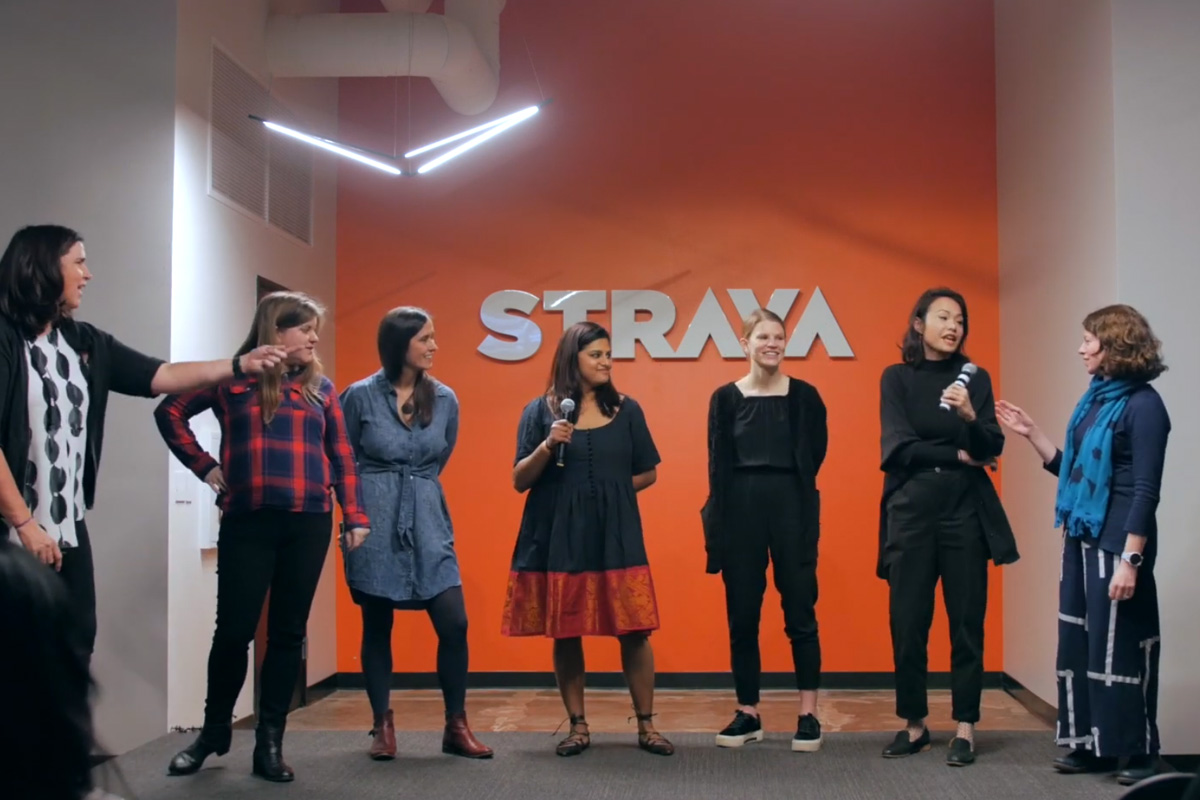
Strava girl geeks: Stephanie Hannon, Elyse Gordon, Lia Siebert, Harini Iyer, Annie Graham, Amanda Sim, and Cathy Tanimura answer audience questions at Strava Girl Geek Dinner.
Cathy Tanimura: I feel like there’s a multi part question and long analysis behind this and my inner analyst is saying, “Okay, wait a minute, let me unpack this.” Why are most users outside the US? I don’t usually have a really great answer. We started here in the US. We’ve been in the UK for quite a while, and that’s a big market for us. Brazil is another huge market.
Cathy Tanimura: I think part of it is that Strava has really grown organically, and we have a really high percentage of new athletes that joined because they heard about it from someone else. And so when you have this kind of organic word of mouth spreading, you don’t necessarily pick all of devices in the world that people start joining from. But it’s been really exciting for us to see that, and it’s really interesting to work on a product where there are so many people who don’t live in the Bay Area.
Cathy Tanimura: Activities most recorded by US versus non-US. It’s a bit market-specific. US is decently mixed between cyclist and runners. UK is a little more run heavy. We see certain markets like Spain is still really cycling-heavy. Up still when Strava went to throne we look across all of our activity-type. Yoga is very heavily female. We haven’t found a majority yoga country yet. Still searching for that one.
Cathy Tanimura: Characteristics that differ US and non-US user groups. Really hard to generalize because they’re actually country-specific things. Brazilians are very social. Someone was recently looking at when people commute, and most people commute at standard times of the day throughout the year, but Italians commute later in the summer. They sleep in.
Cathy Tanimura: There’s some interesting patterns like that. People in the UK are really into making New Year’s resolutions and work out a whole lot right after the New Year, and have a clear drop off and it’s a little more mixed in other countries. So really it differs. I could go on and on, but I won’t. But if you really want to work on interesting data, come talk to me.
Stephanie Hannon: I just want to add we’ve an addition to the organic community growth, which I think is completely accurate. We’ve also put Strava employees on the ground in many countries, and found that intervention, and building the brand, and building the community ourselves is really important. We’ve also started a program this year to do that in cities in the US. So we’re hiring internationally, and in cities in the US to do more of this type of growth.
Stephanie Hannon: So the next question is about features. And the question is, how do you decide which features to make available on the web versus mobile? The web interface is so feature-rich compared to the mobile iOS app. Lia is going to take this one, but also remember that for a long time, Strava was a web-only product, which is different than most companies you encounter. In the early days, computers were the only way you got data into Strava. It was much later that the mobile, and the record experience came around. Oh, you have it.
Elyse Gordon: Yeah. Hello. Hello. Great. I will speak on behalf of how I approach my work. I know this is a hot button or different depending on the teams. It really depends first and foremost on the hypothesis of the question that we’re trying to answer. So, it may make sense to do something in a really exploratory way on the web because we can do that quickly, and because the engagement that we want is in the right place.
Elyse Gordon: If it’s checking those boxes, I’m more than happy to pair with one of the web engineers on my team to advance a question, and a hypothesis in that way. On the mobile apps, similar. For us working in the feed with some of these partner integrations that I shared, any of the social feedback that people get. So much of that is happening in the following feed on the mobile apps that I need to see what the engagement looks like there.
Elyse Gordon: I would say it’s not one-size-fits-all. Chasing parity for parity’s sake can be a quick way to blow up a road map. I think what we do is just step by step way, what question are we trying to answer, and what is the right platform to move that forward. But probably, most of what we’re seeing is Strava has to do with that history.
Stephanie Hannon: Great. I think — can you dismiss the questions we’ve already answered? I think we have time for two more. This is a test. Here, hold that. Popular. Okay, let’s start there. Do you recruit people coming from community college or boot camps? In other words, not from well-known universities. How old is the oldest worker? Oh, Cassandra, do you want to come up and answer this? Or Jenny. Oh, Elyse is going to do it. Yeah.
Elyse Gordon: Okay. I think in recruiting at least for engineering, the background … What?
Audience Member: [inaudible].
Elyse Gordon: Yeah. Well, I was going to say your background is really less important than what you can do, or what you could show us that you can do some day depending on what we’re hiring for. We actually have lots of people working here with, what? A variety of non-traditional backgrounds. We have boot campers, other non-traditional backgrounds. I didn’t talk about this in my talk, but I do not have a computer science engineering degree. There’s a lot of other people here who don’t. There is no one right path to get here, right?
Stephanie Hannon: Great. I don’t know if I know the…old…age of our oldest worker.
Strava Team Member: We don’t.
Stephanie Hannon: Okay. We don’t. I fear it might be me. I’m just looking around, it’s awkward. This is the last question. I know the Girl Geek X team was especially hoping I would answer one question on the Hilary campaign. And I think yeah, woo. It’s a weird question. I know because I’m checking on my mobile, it’s the next most popular. The question was, what was one thing we learned from data? I just want to say hi to Vanessa over there, if you can smile. She is my dear friend. She was on the Hilary tech team. She’d be happy to talk about it too after this talk is over.
Stephanie Hannon: But data was at the heart of everything we did at the Hilary campaign because at the core of it, you spend your time modeling voters. And you’re trying to figure out their level of support for your candidate, and the likelihood to turn out. Those two things help you figure out everything. It helps you figure out where to put field staff, where to spend your advertising dollars, what channel to try to reach people. It’s much cheaper to reach them on social media, or a radio ad than to send somebody to their door, or send them a paid message.
Stephanie Hannon: It affects where Hilary went, and where we sent her plane, and whether she did big events or small events. It affected everything. So data was at the heart of every part of the campaign. Probably one of the most important things I learned early on is it’s way more important to activate supporters than to persuade people. Disproportionately, democrats don’t turn out to vote. And there’s all sort of demographics, logistical, institutional law reasons that is hard.
Stephanie Hannon: But activating supporters was our number one goal. And so, that’s one way data influenced, or one insight I had about data from early days of the campaign. I know Vanessa and I would be so happy to talk to anyone afterwards who wants to dig in. Okay. So if you can switch back to my other slides. This is the last plug, I swear. Last plug. If you have a great job, and you’re happy where you are, but you have a friend who wants to work at Strava, the same URL is appropriate.
Stephanie Hannon: I want to thank the Girl Geek X team. I want to thank Cassandra, if you can wave. Just do it. She and the team of recruiting here at Strava did an extraordinary job putting this together. I just want to say thank you. Thank you to these amazing speakers. I think especially to all the Strava employees in the room, we didn’t know Harini was such a comedian, and her profile, right? I think we’ll be playing this over and over for much time to come.
Stephanie Hannon: And the last thing to thank all of you for any of you who haven’t tried Summit, which is the subscription version of Strava. It has a lot of the features I mentioned today like: Beacon, some heart rate analytics, lots of valuable features. If you haven’t tried it yet, this is a code to get one month free. Okay. One month free of Strava. We’re going to send an email with the same details. This will only work for you … Even if you’re already a Strava athlete, it will work for you if you subscribed on the web, or if you’ve never been a Summit athlete.
Stephanie Hannon: If you subscribed on mobile, it’s just not going to work. But, if you’re an engineer, come here and help us fix that. Don’t be mad. Just come work here, and together we can fix that. That’s all. We hope you’ll mingle. We hope you’ll meet more people, and meet each other. Thank you for coming.
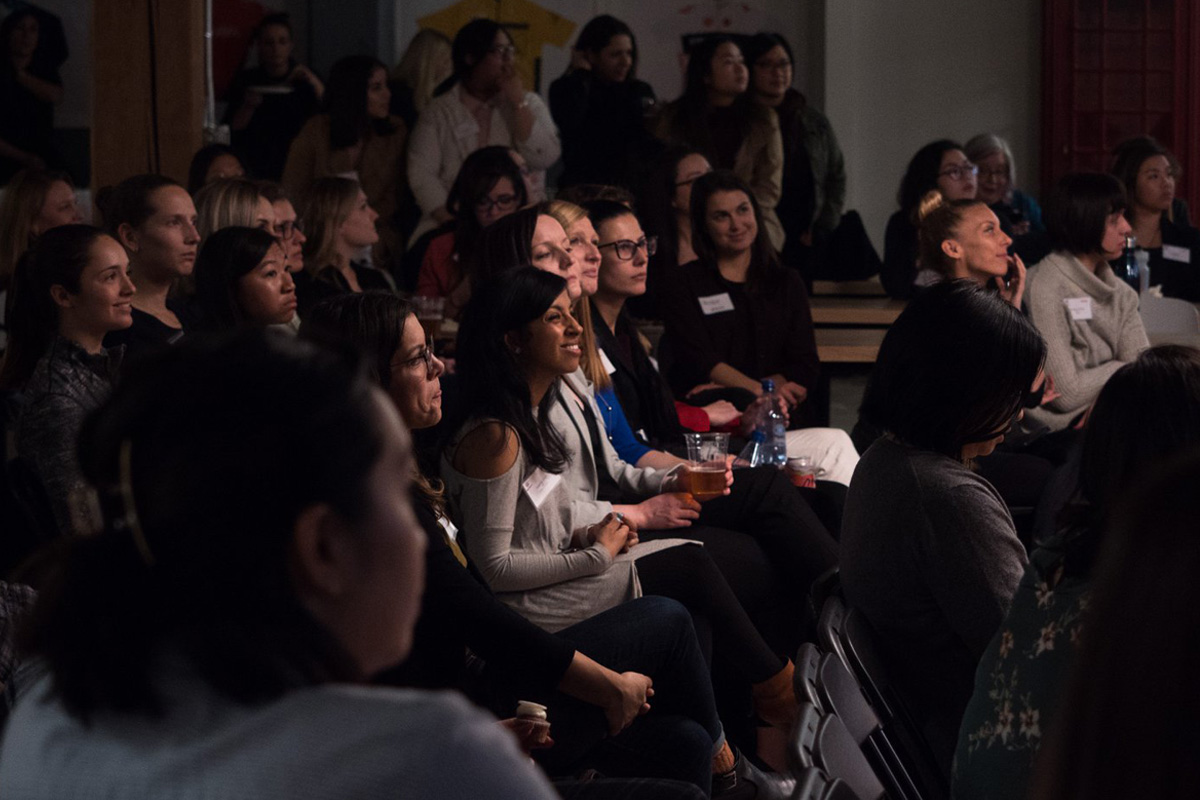
Thanks to everyone who came out to the sold-out Strava Girl Geek Dinner in San Francisco, California.
Our mission-aligned Girl Geek X partners are hiring!


